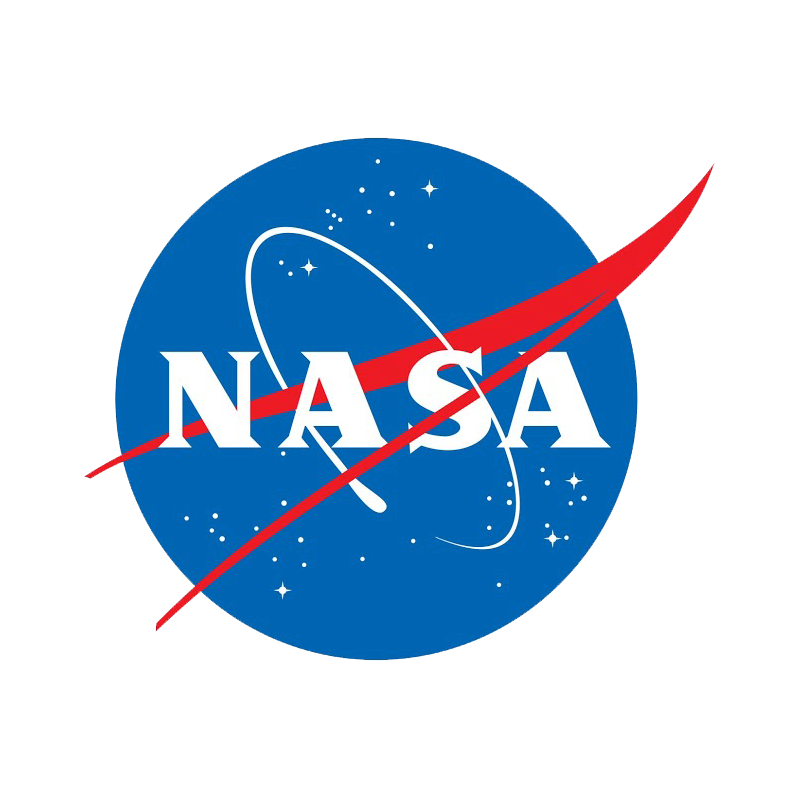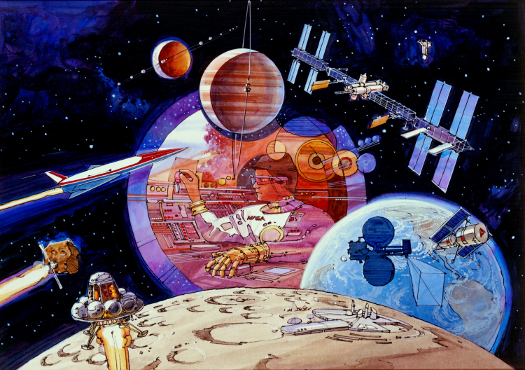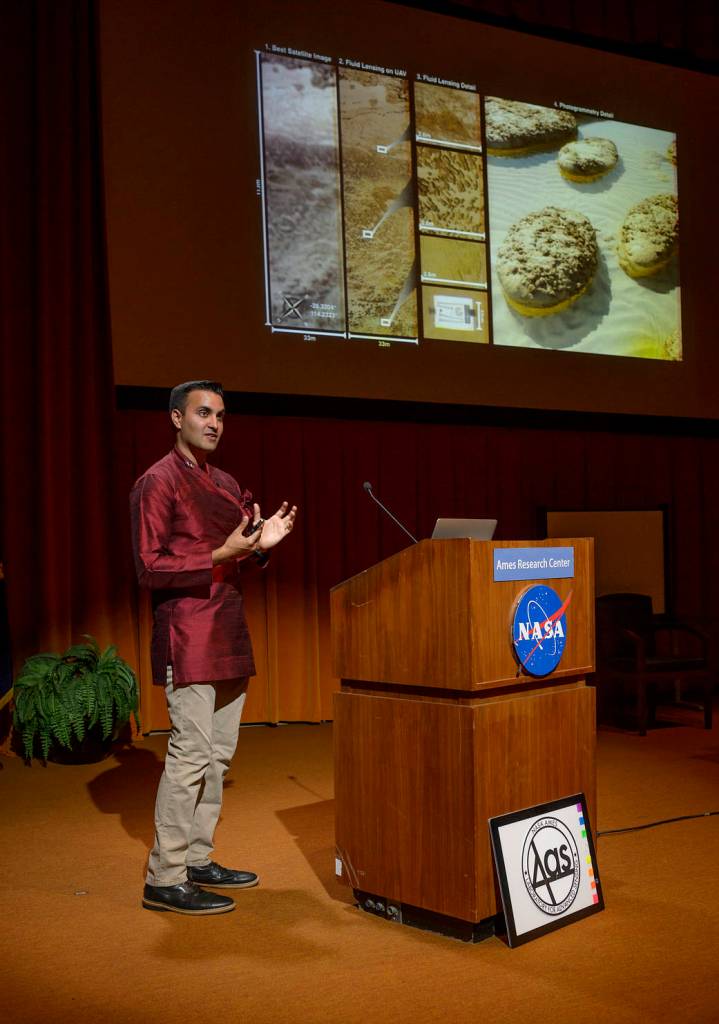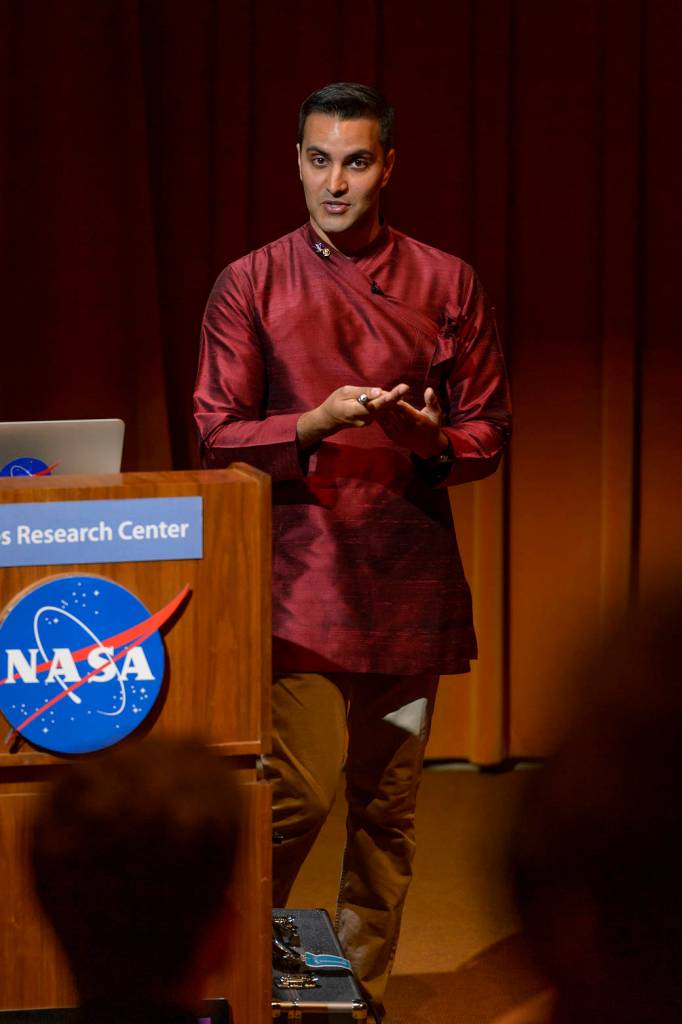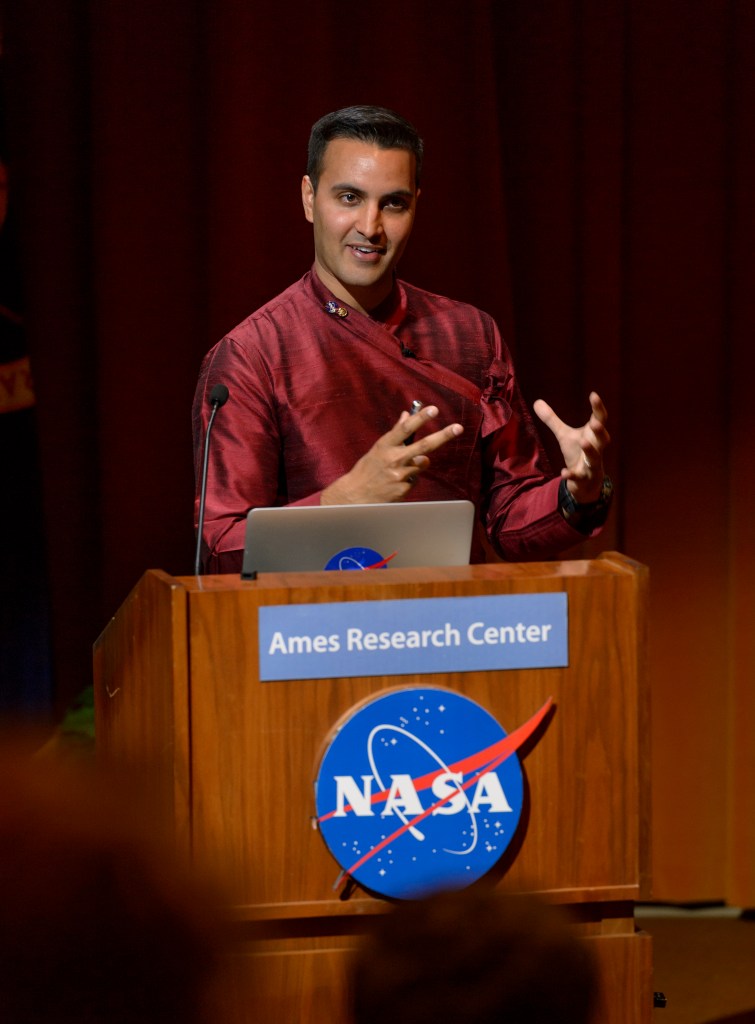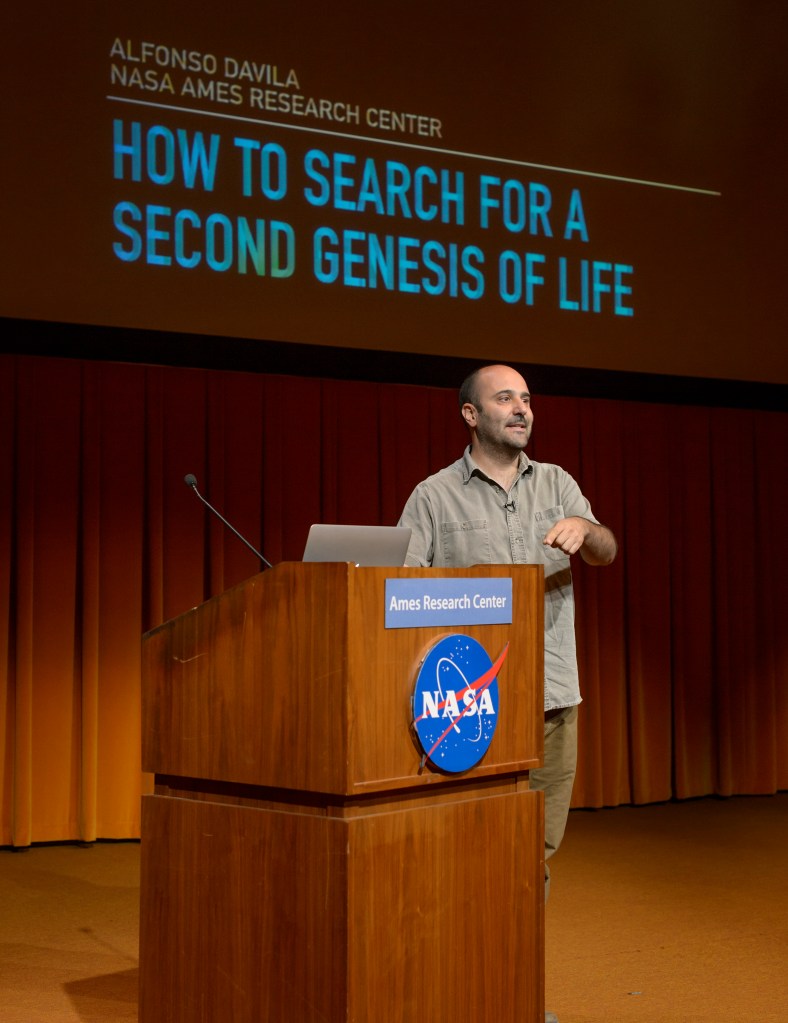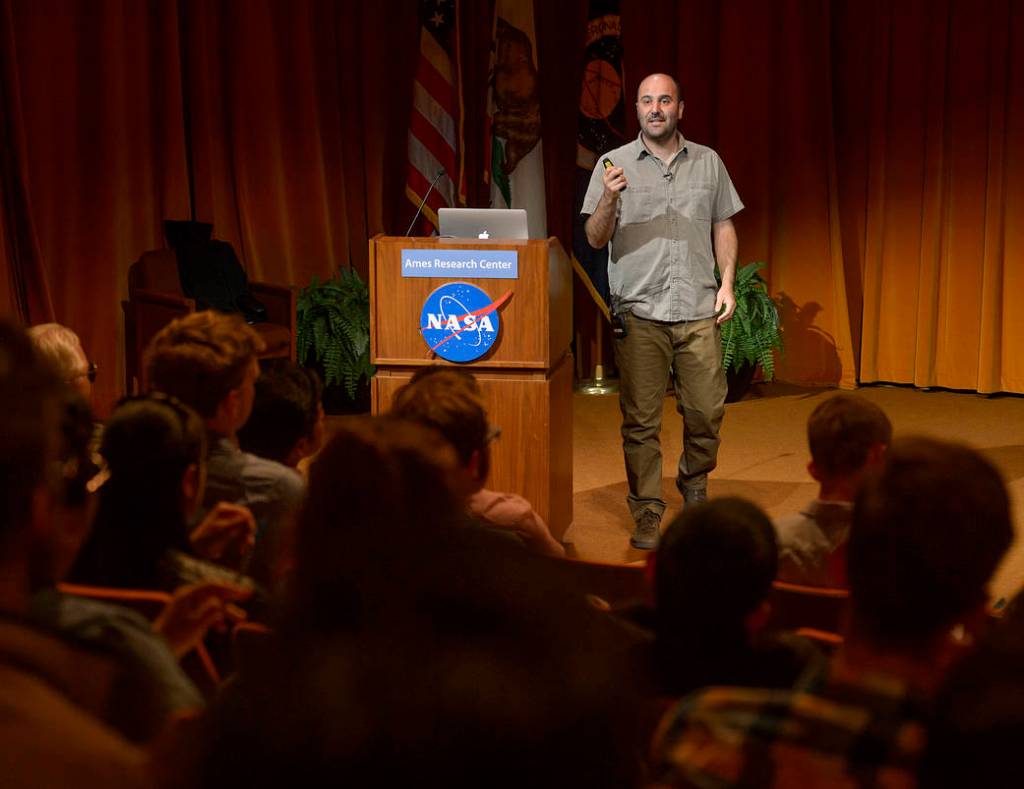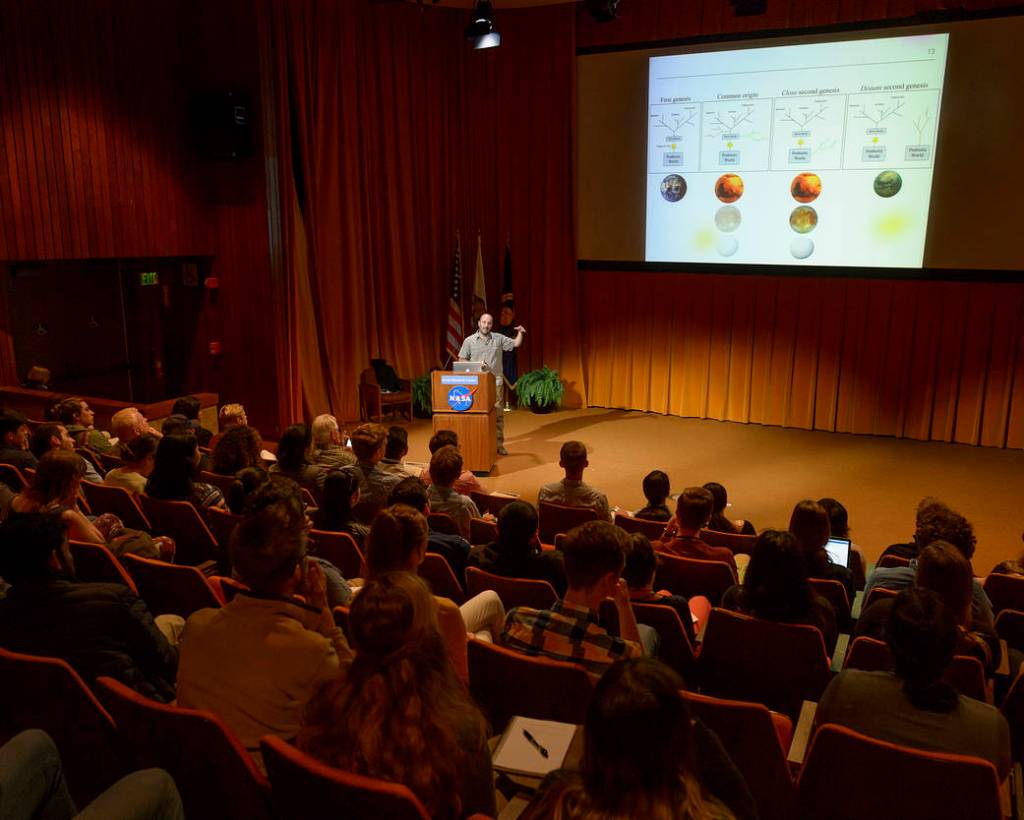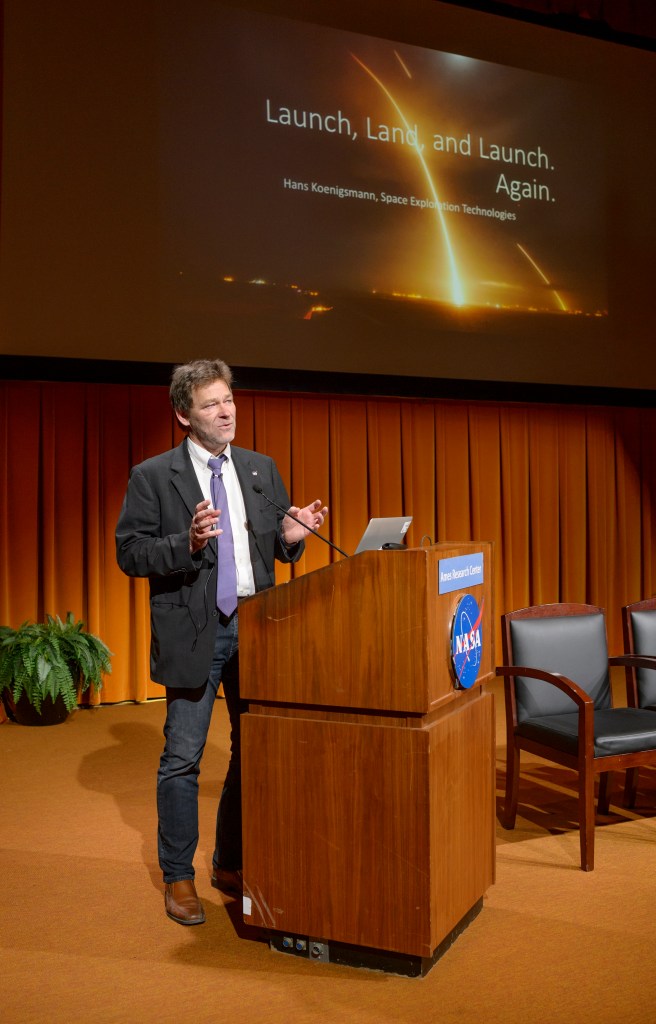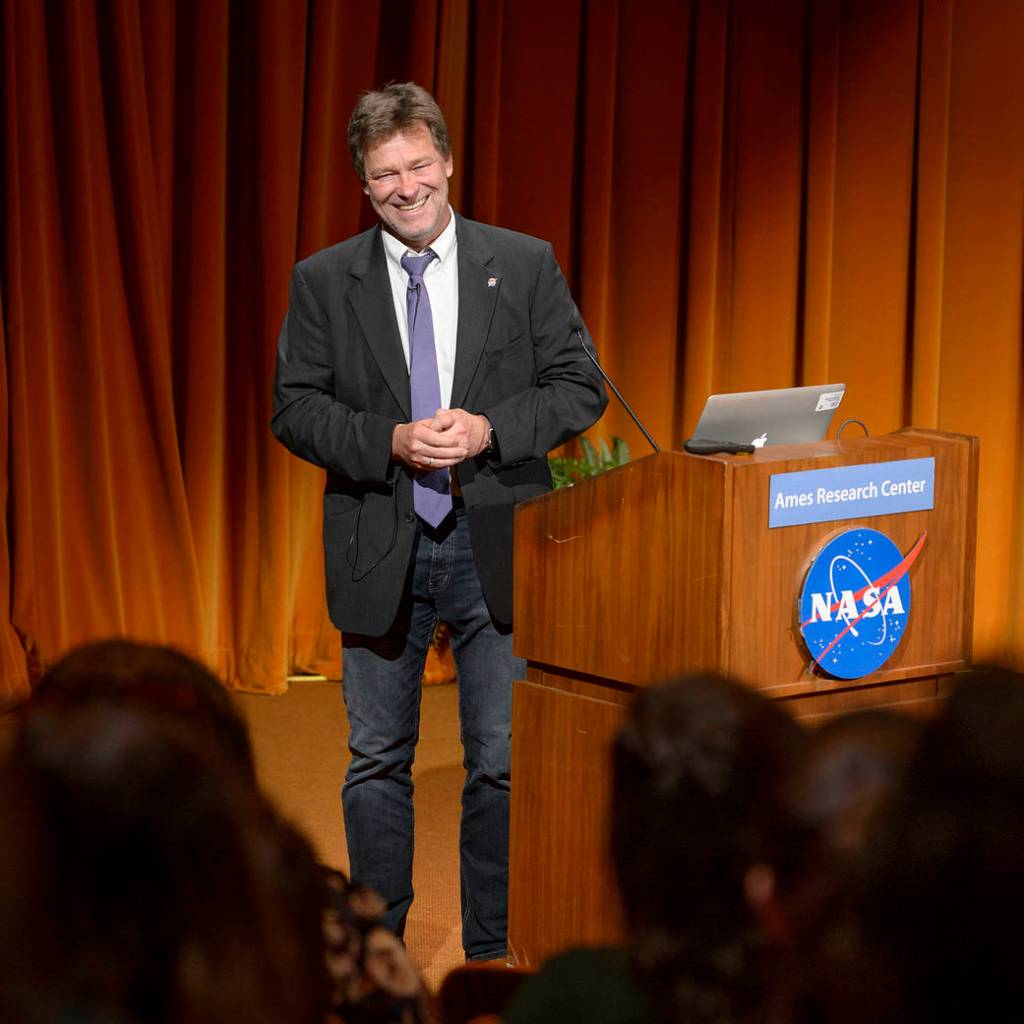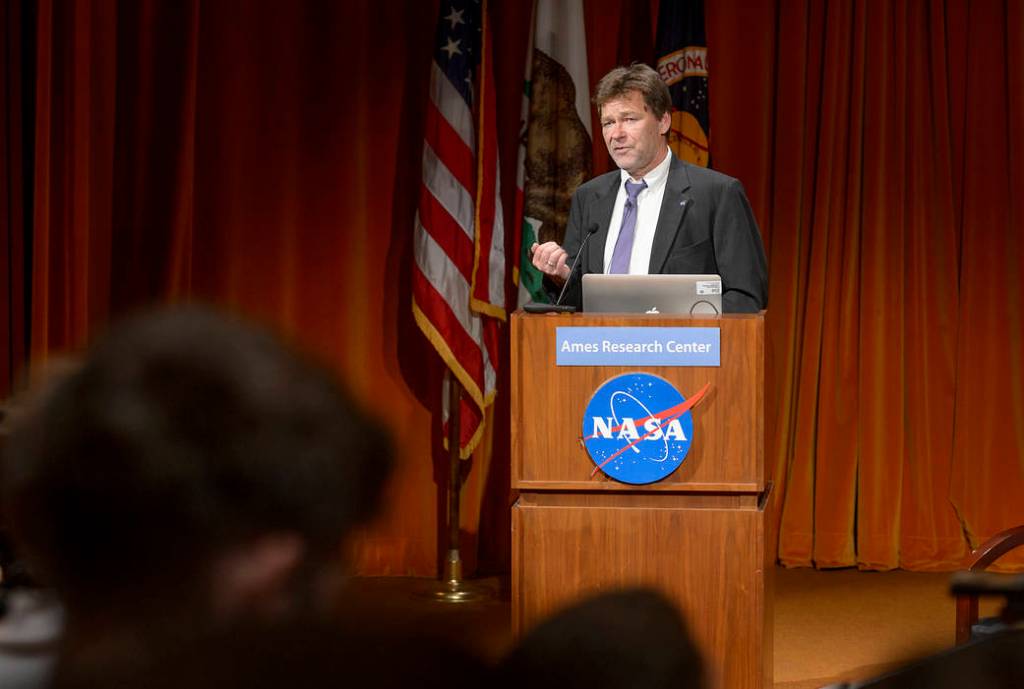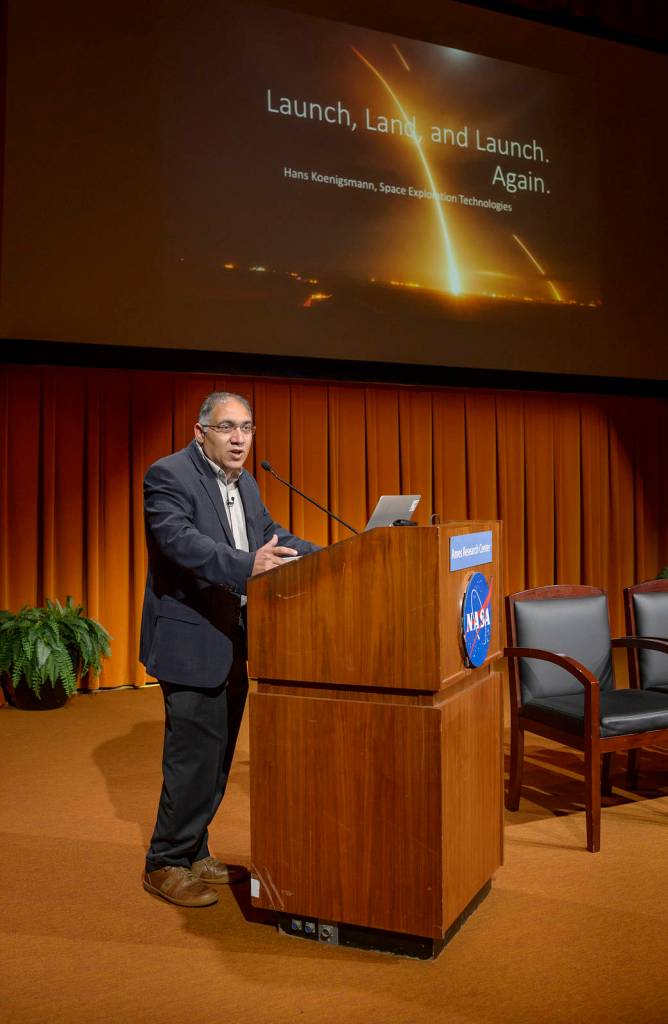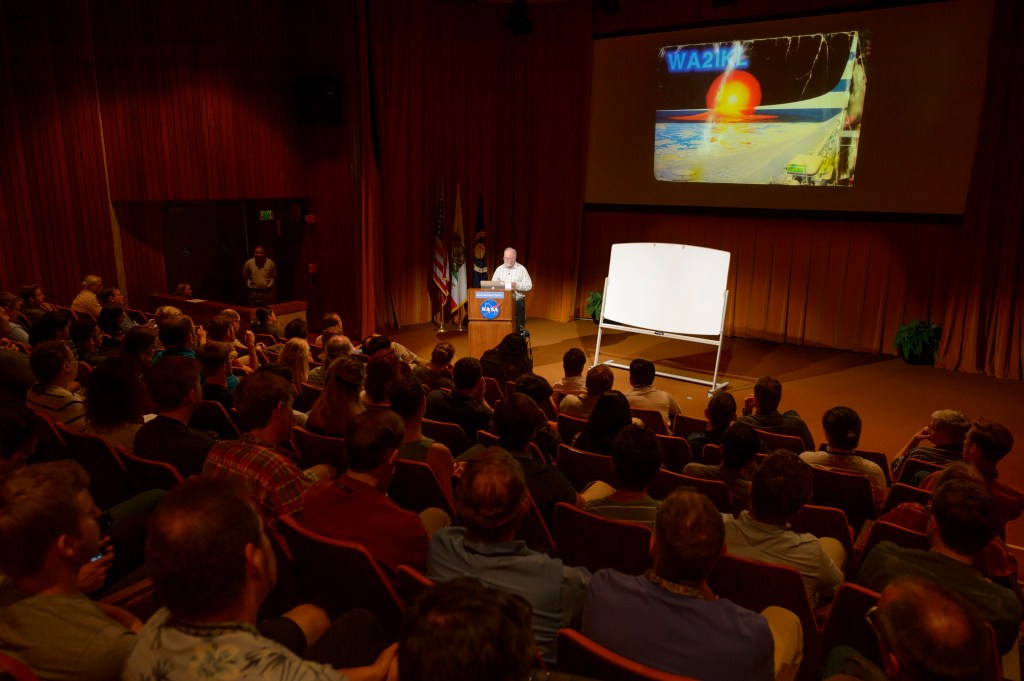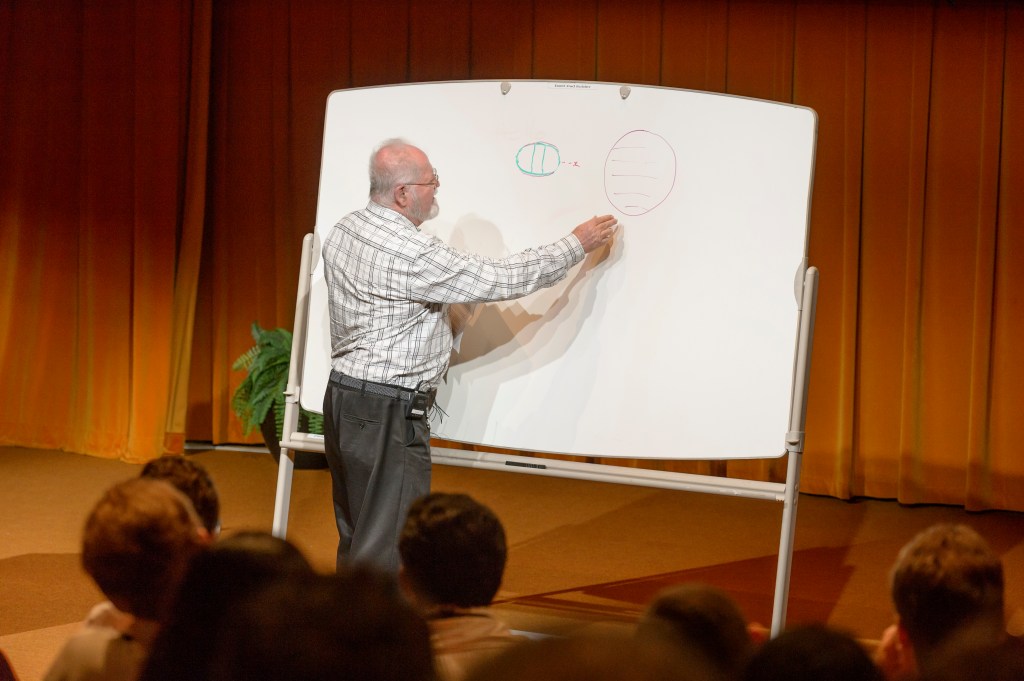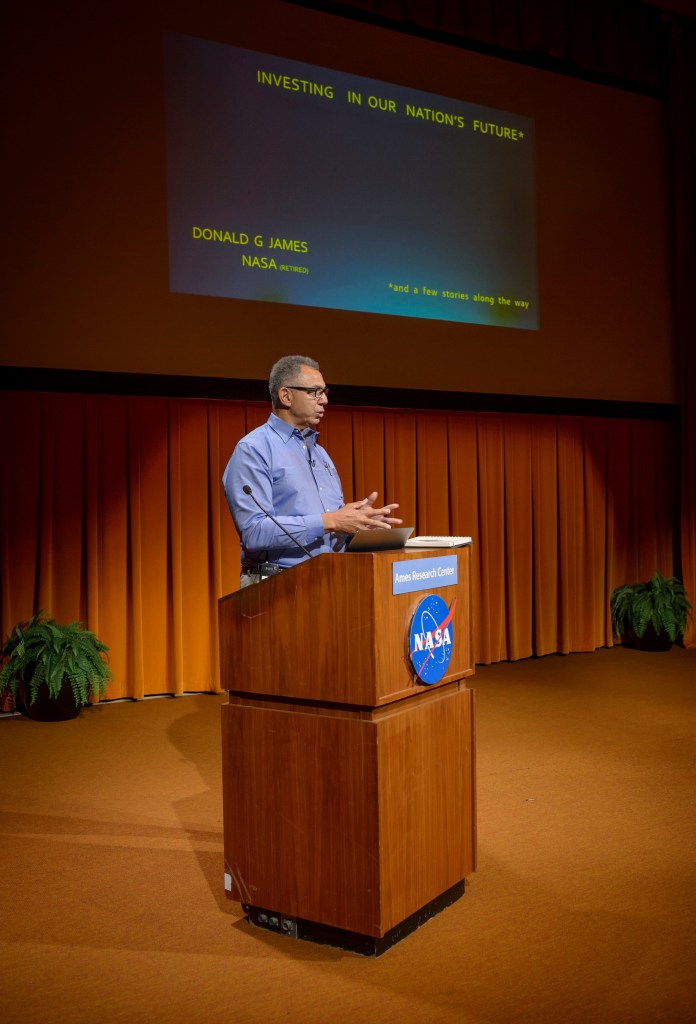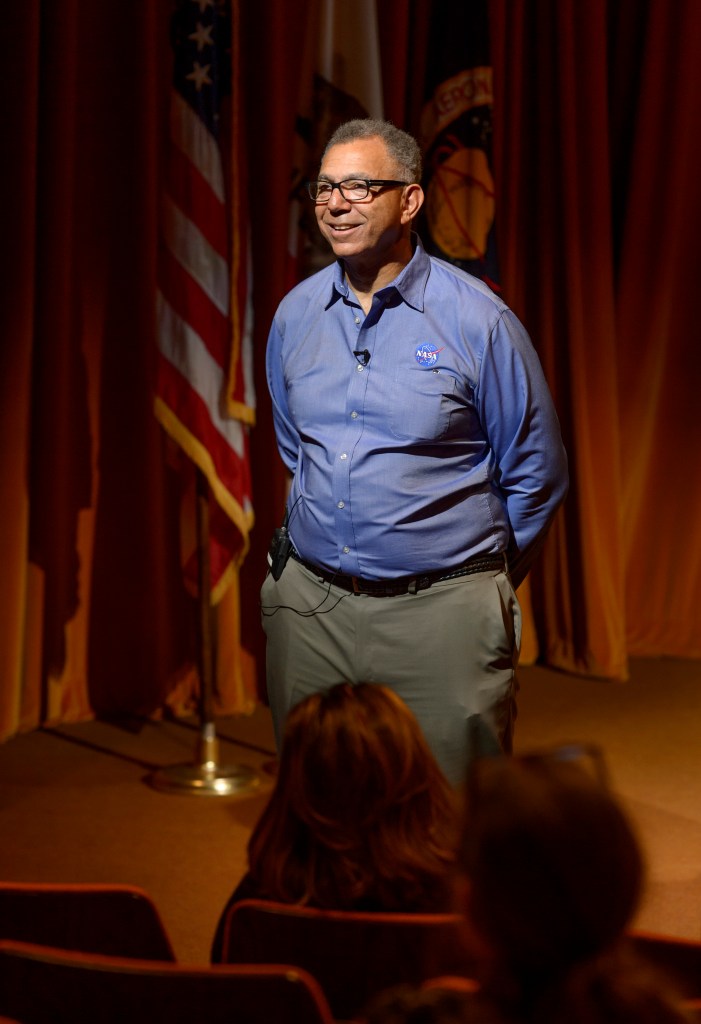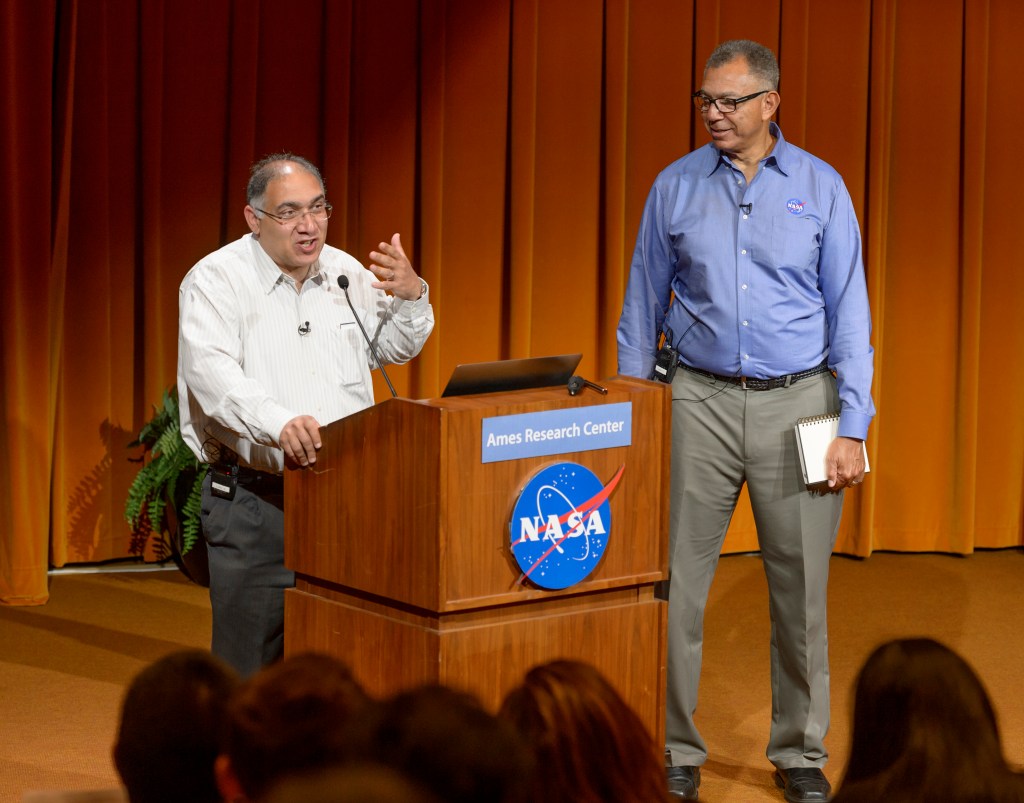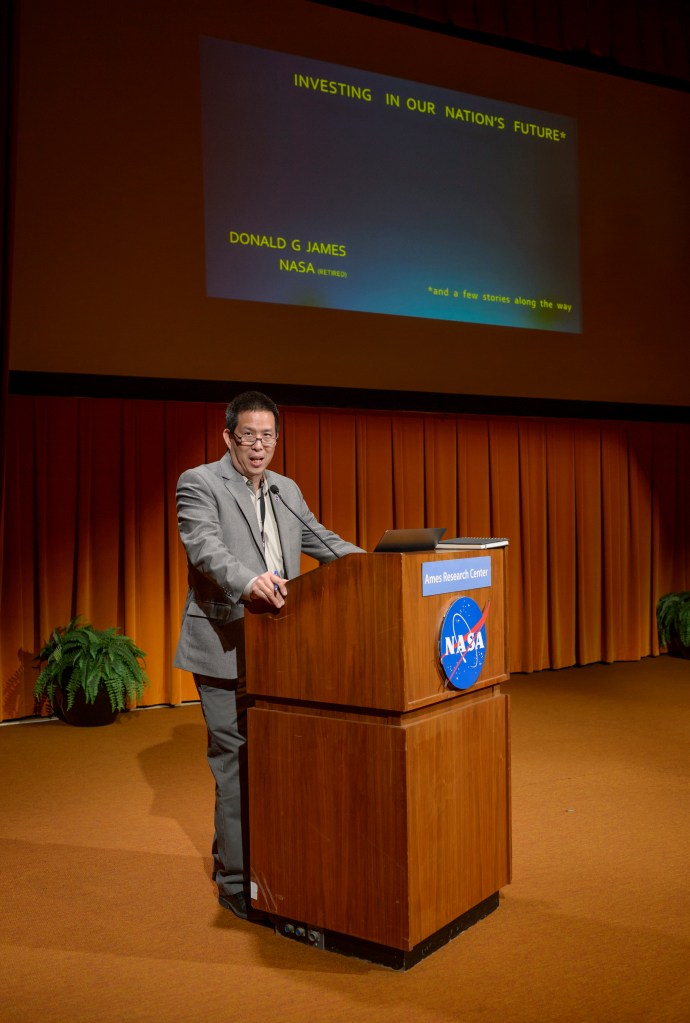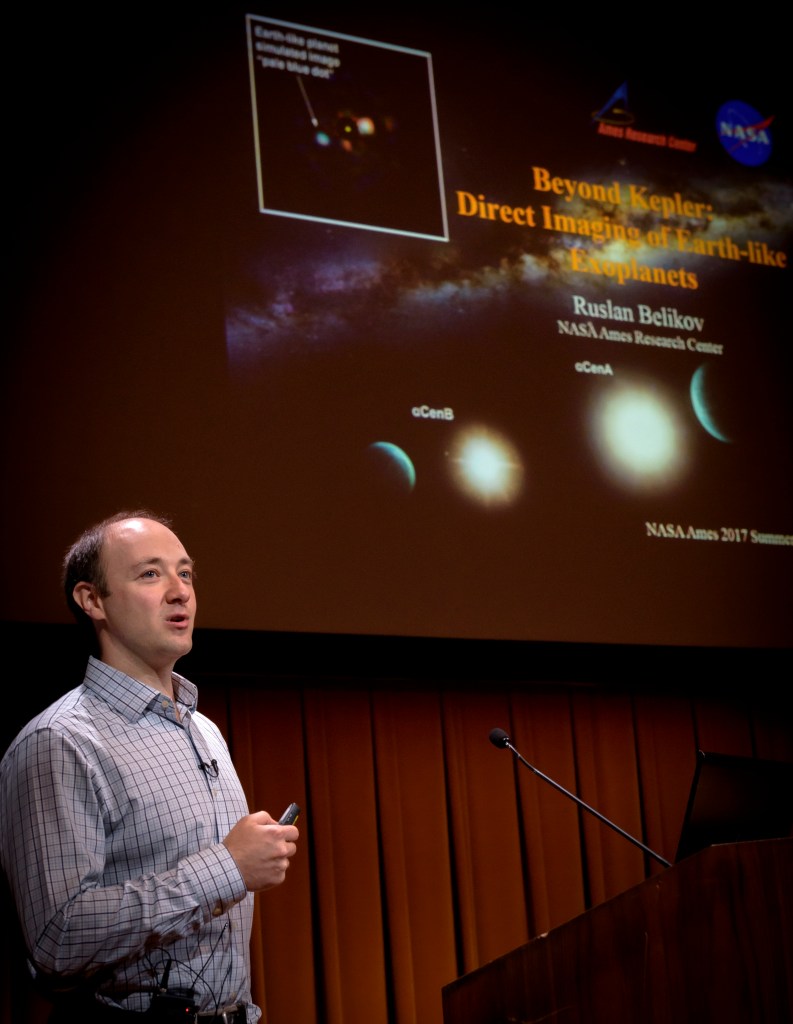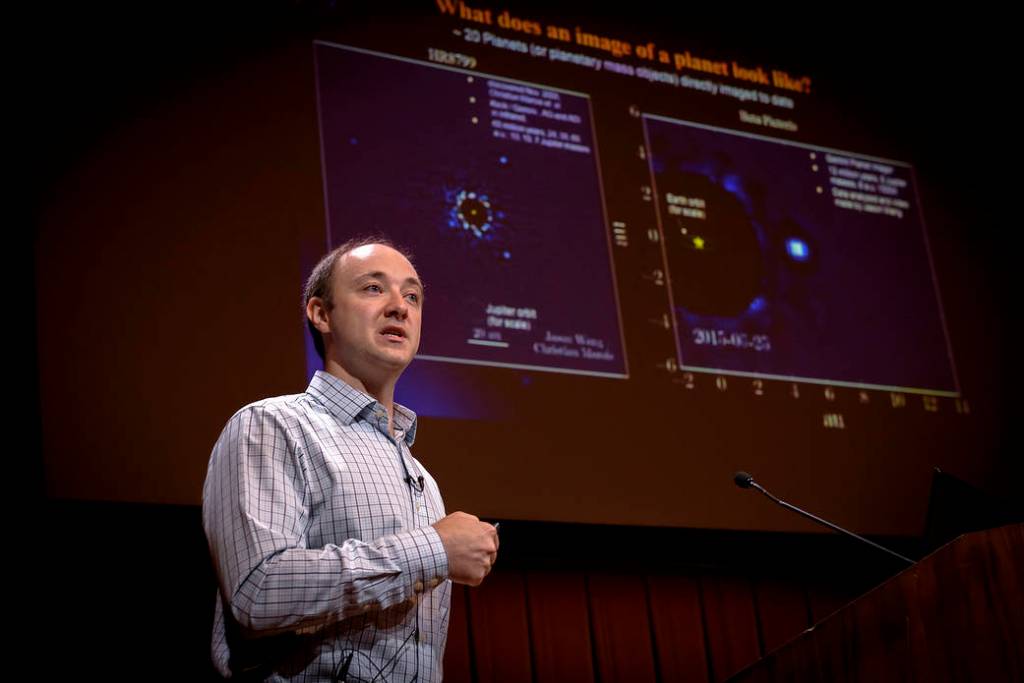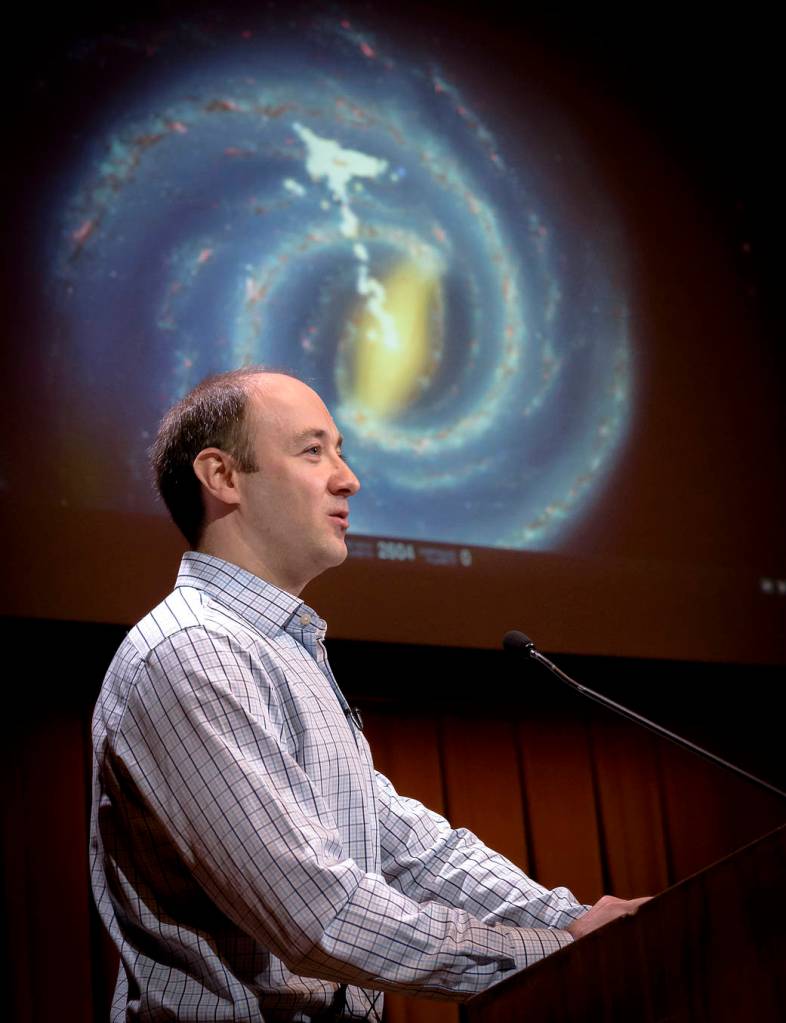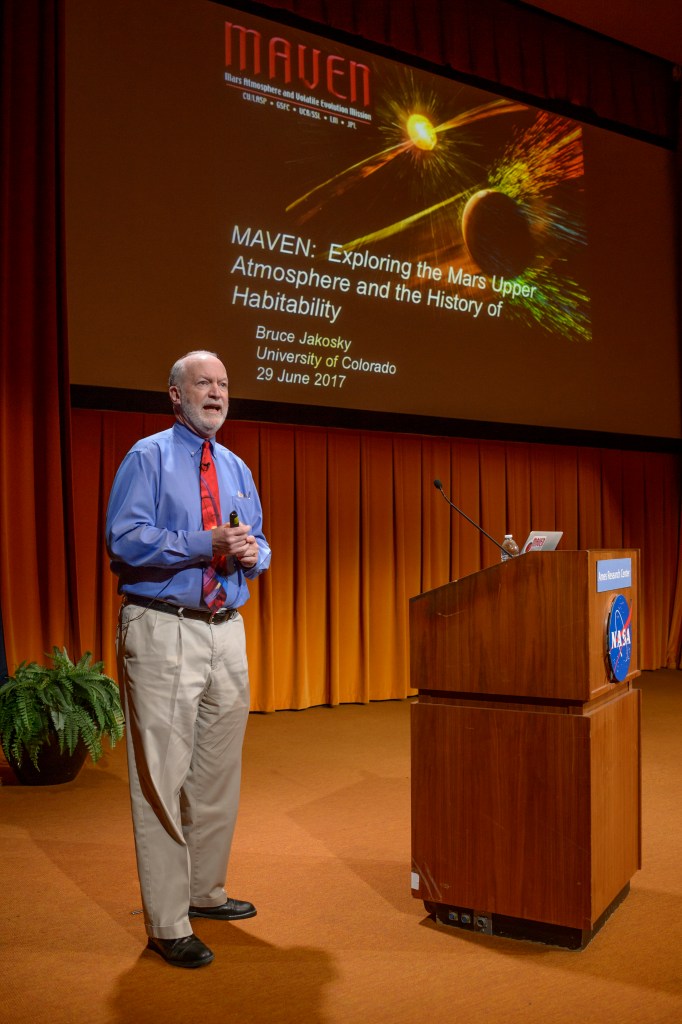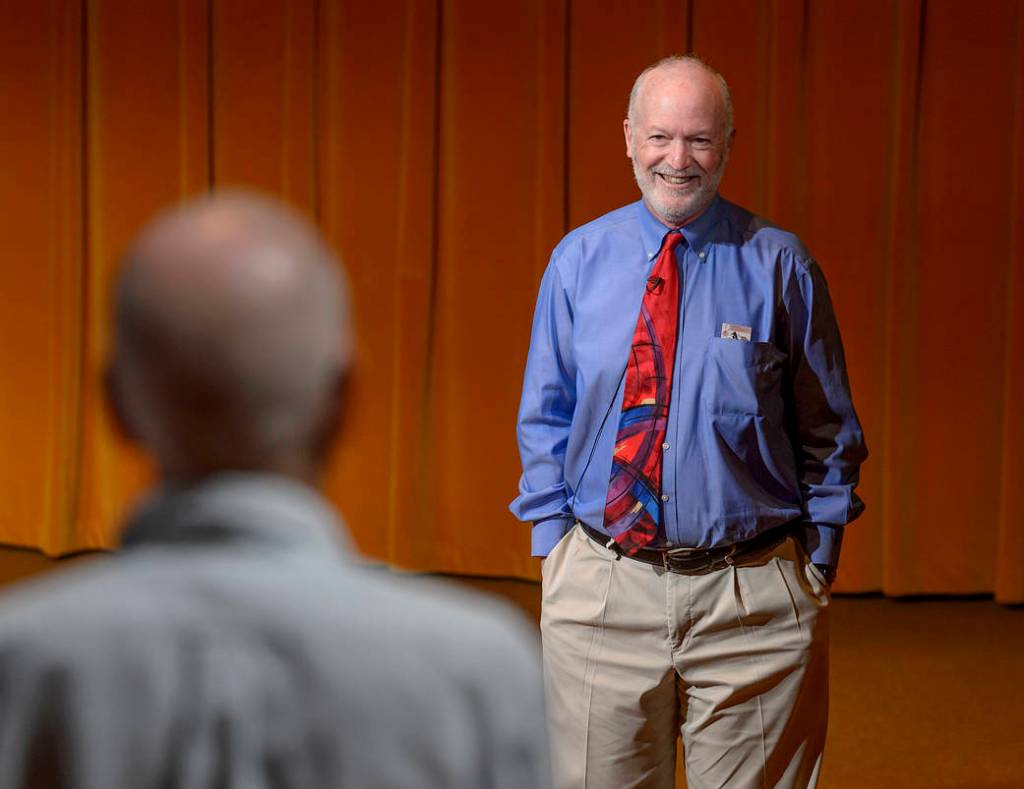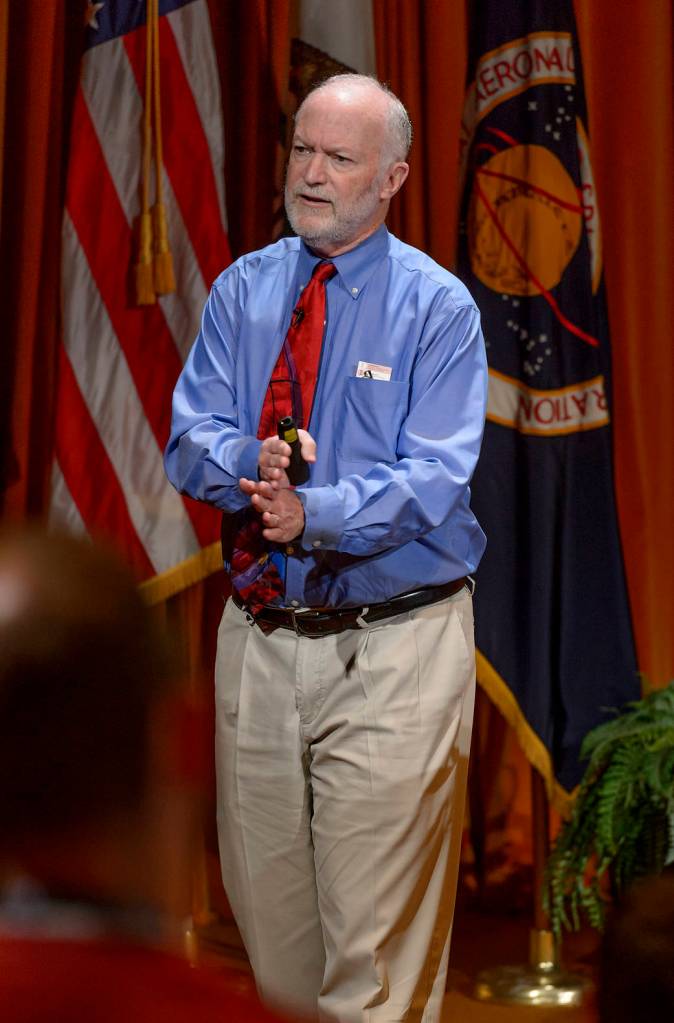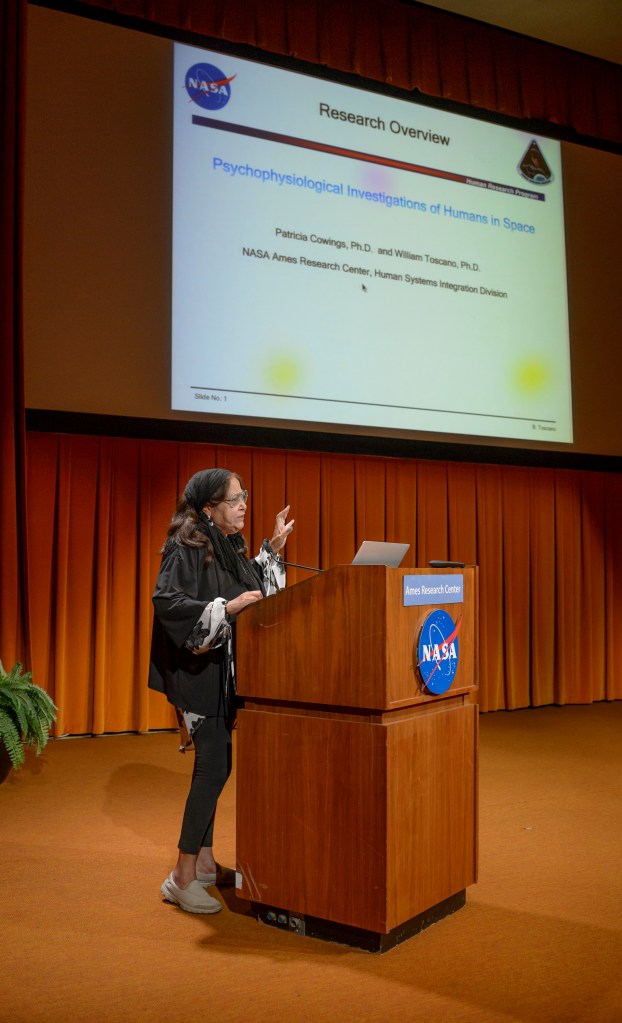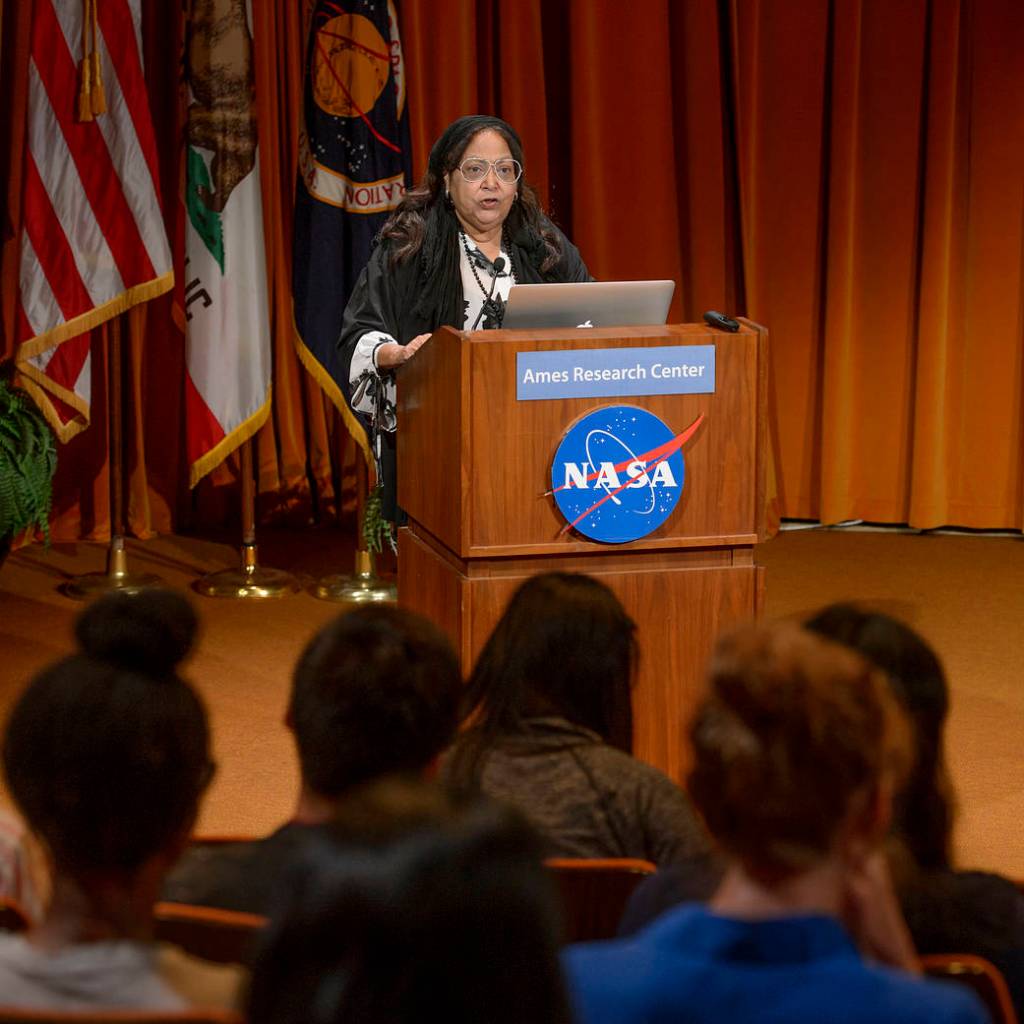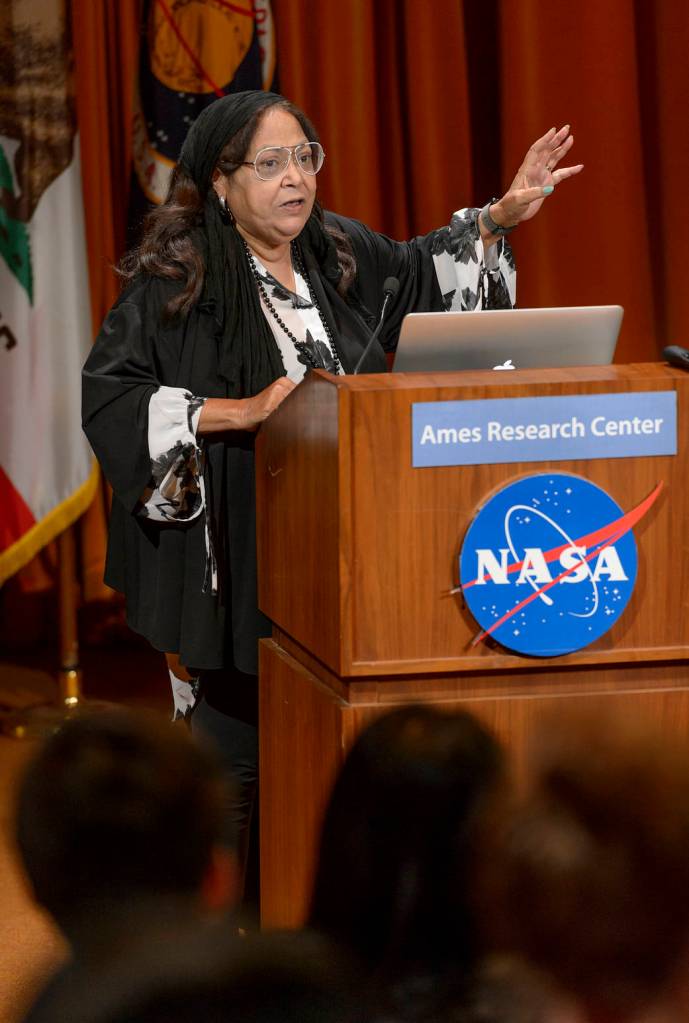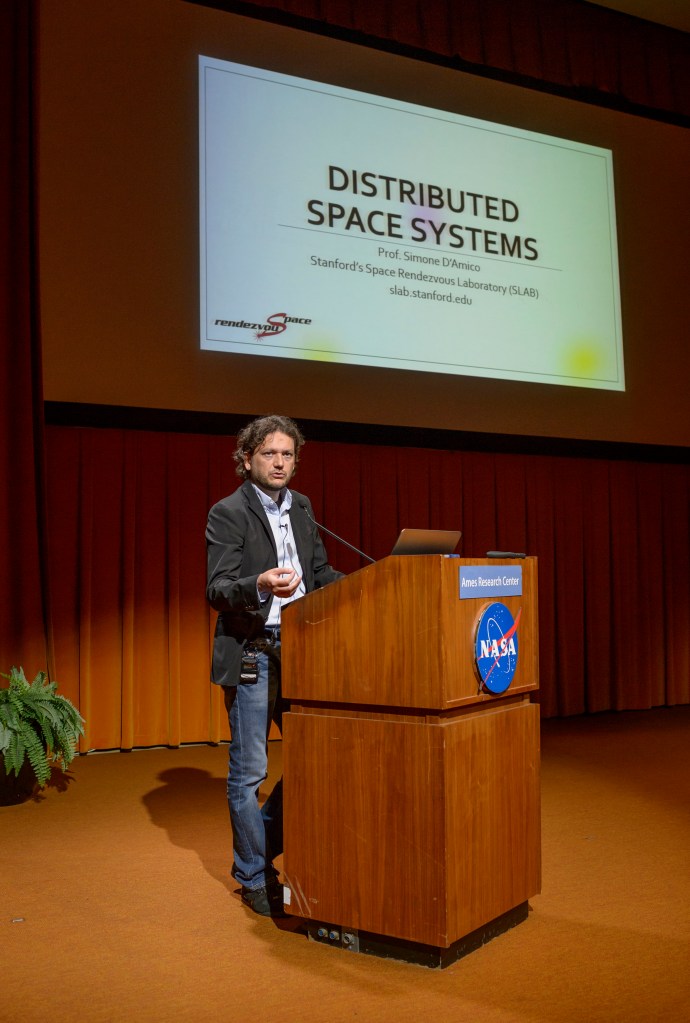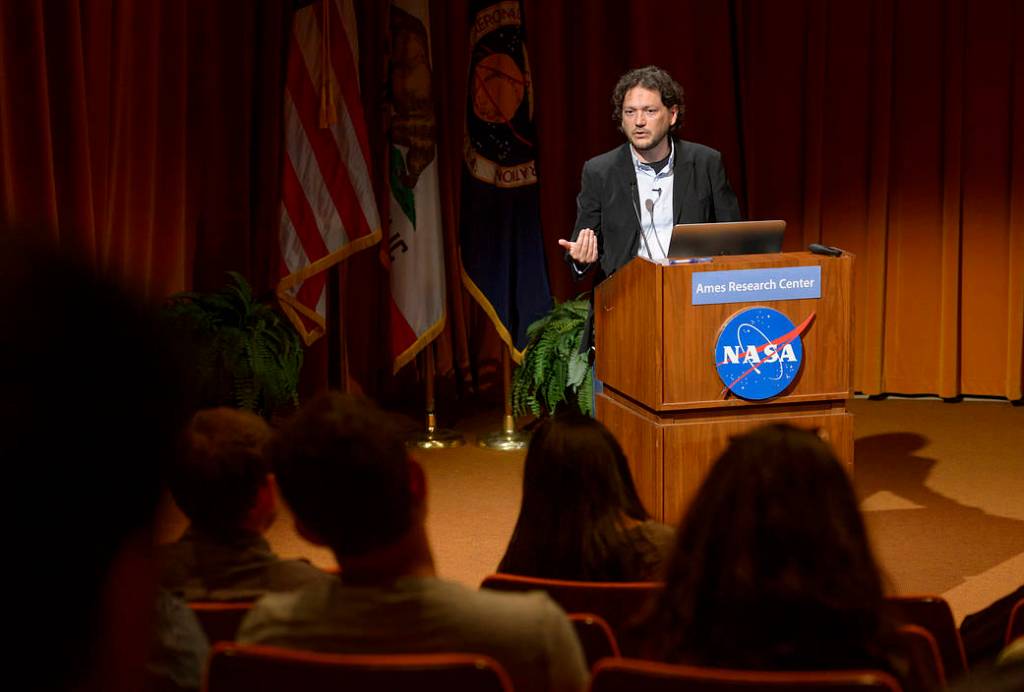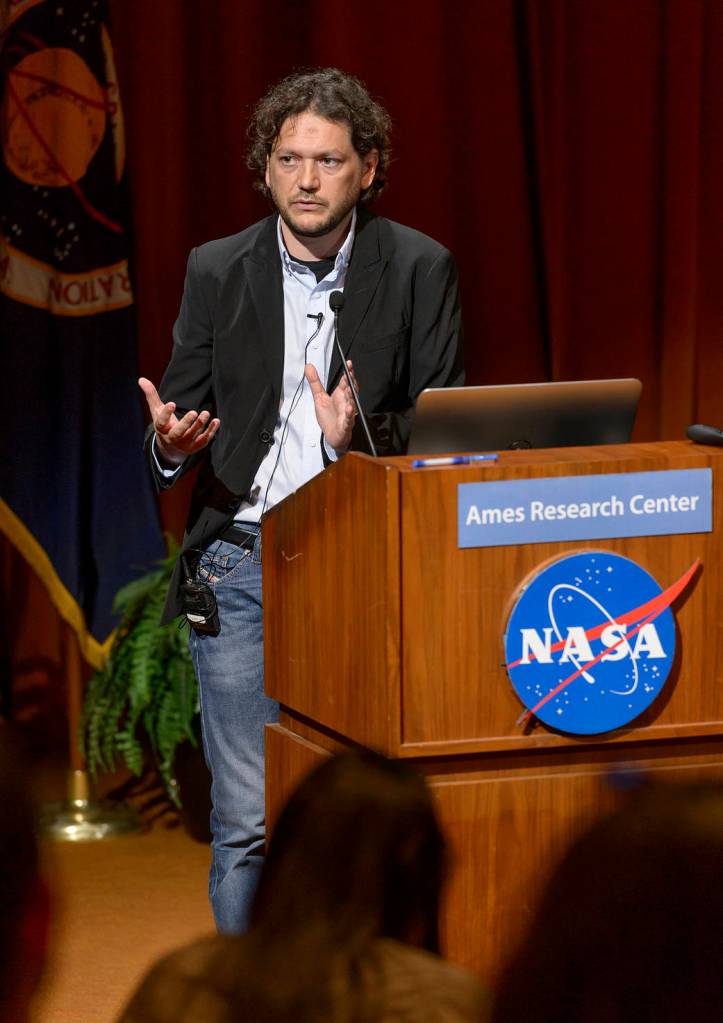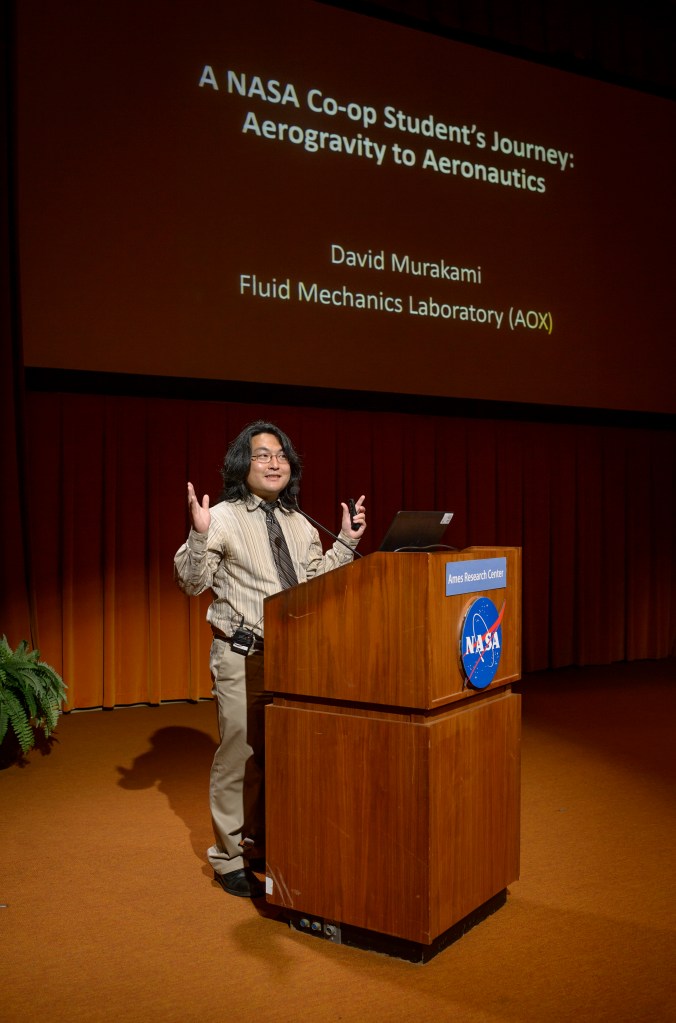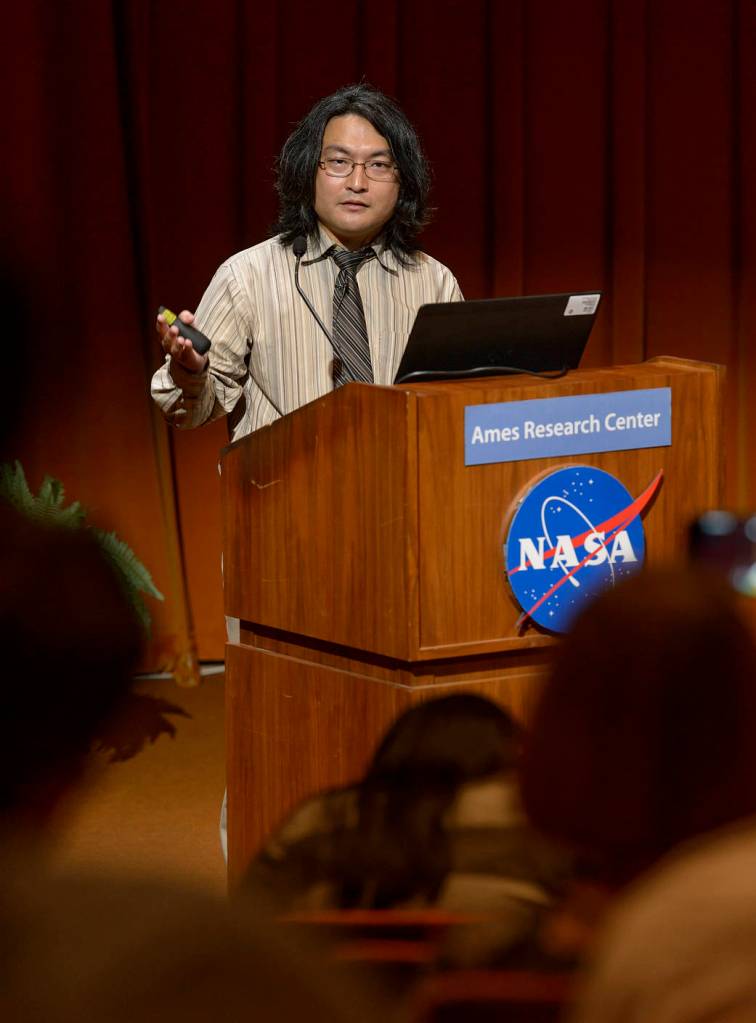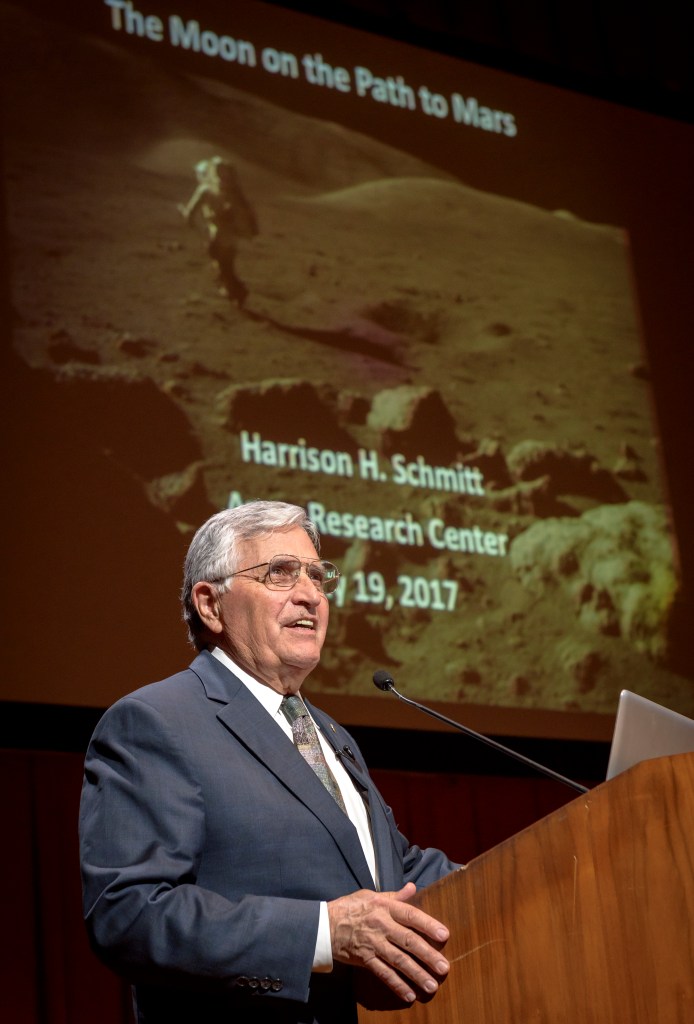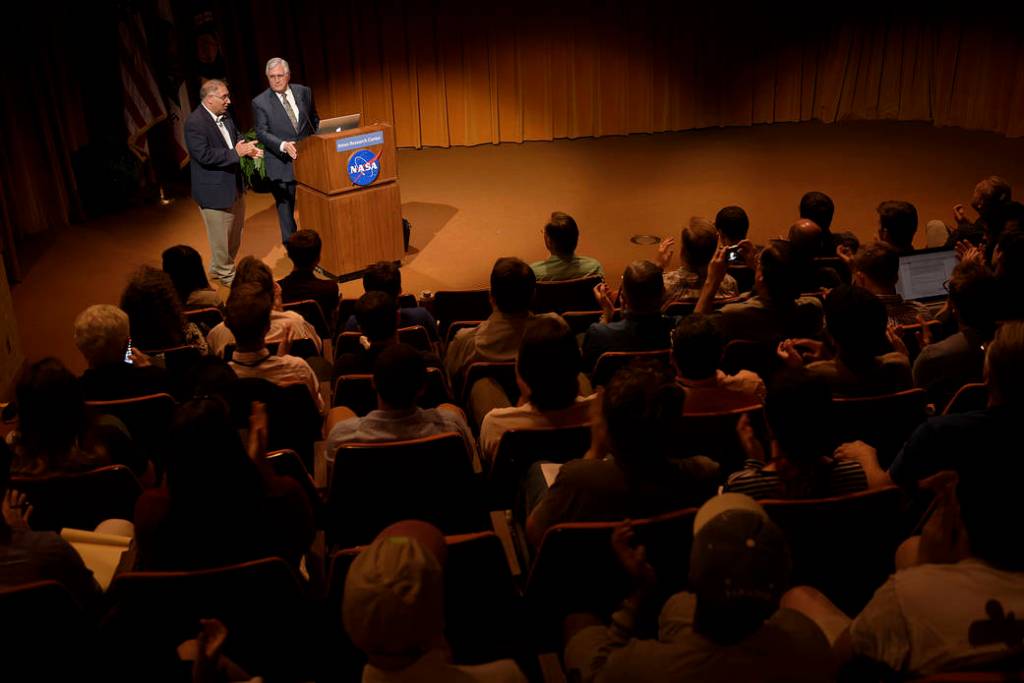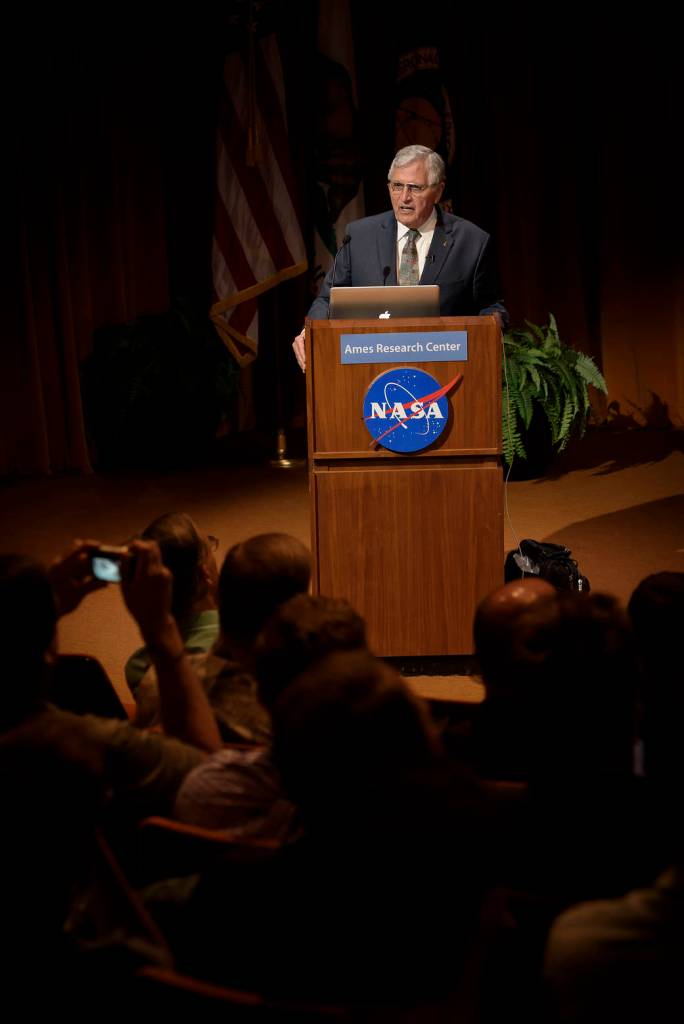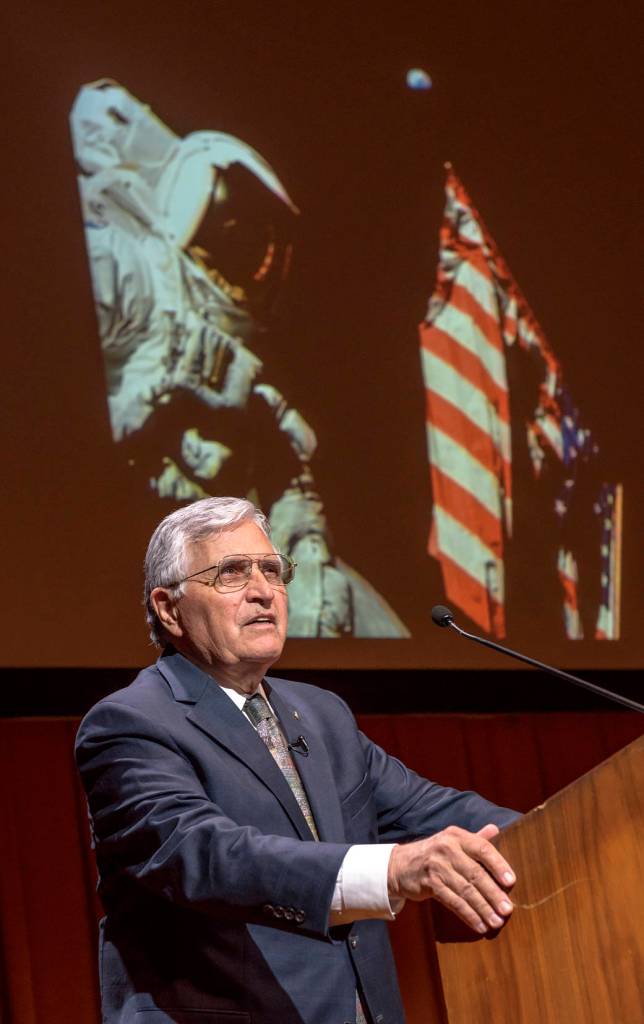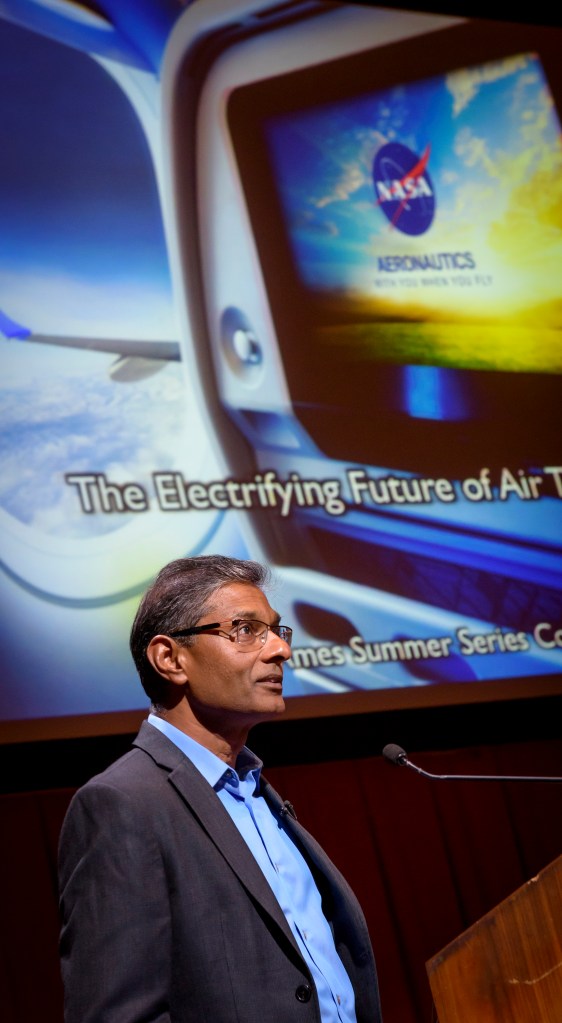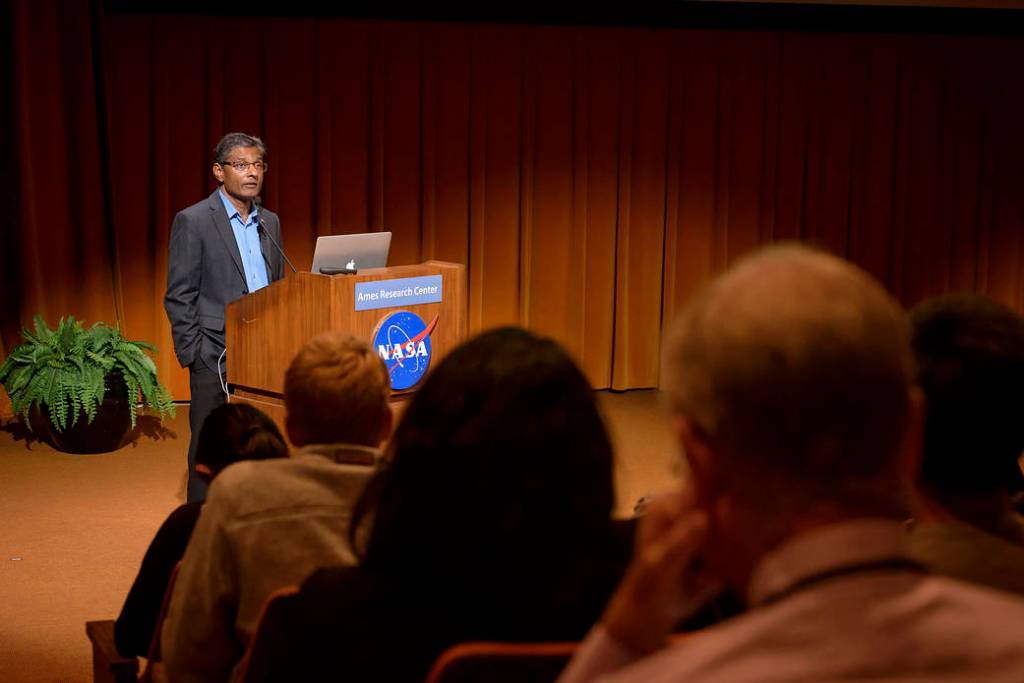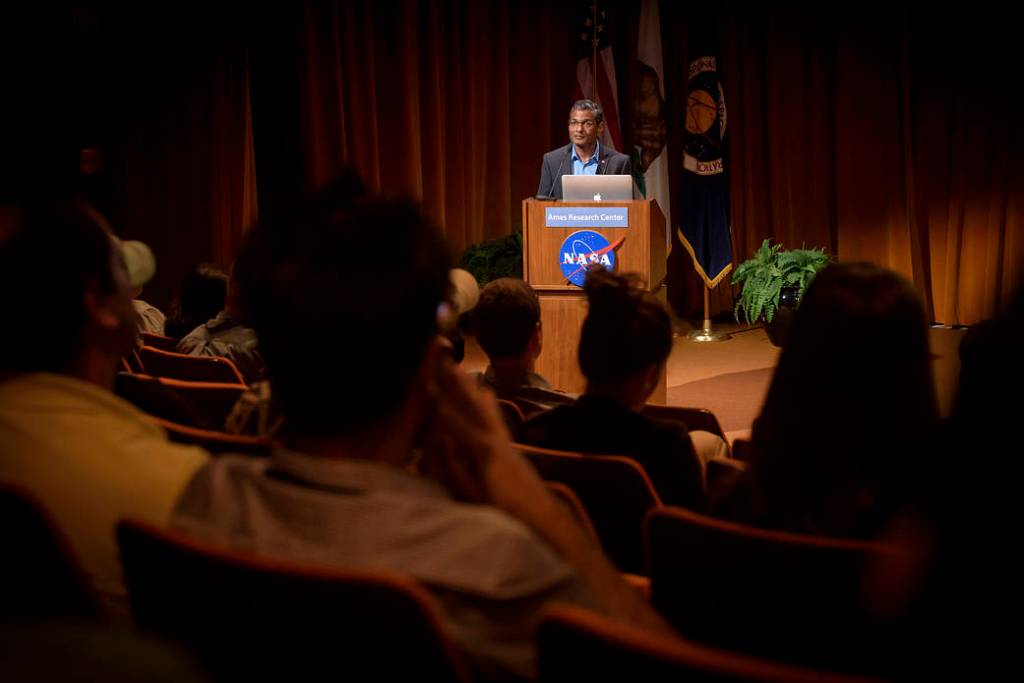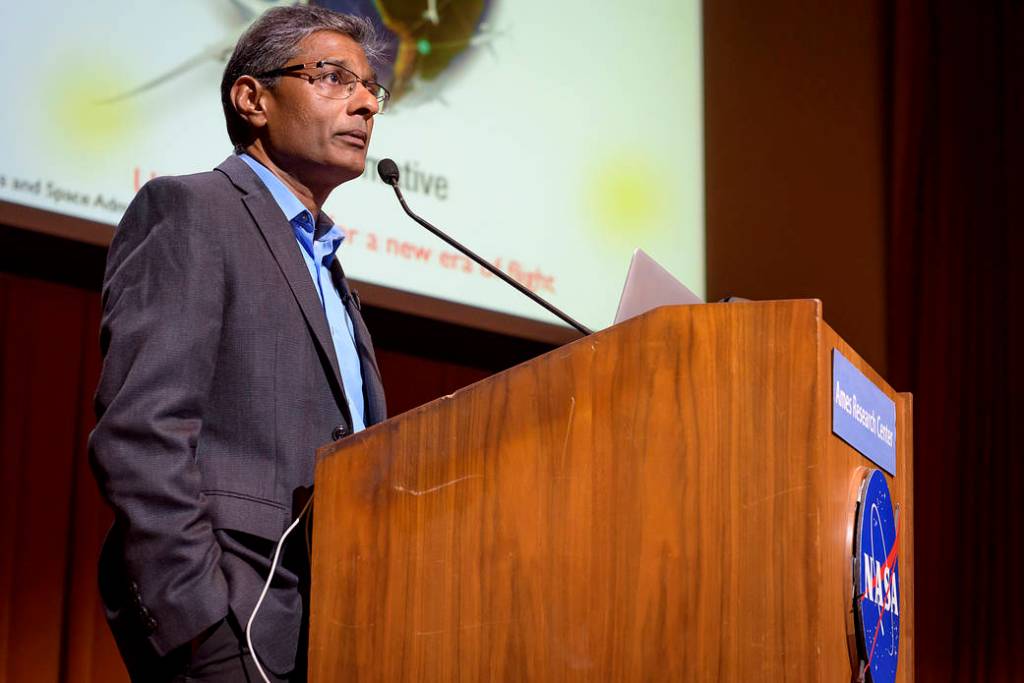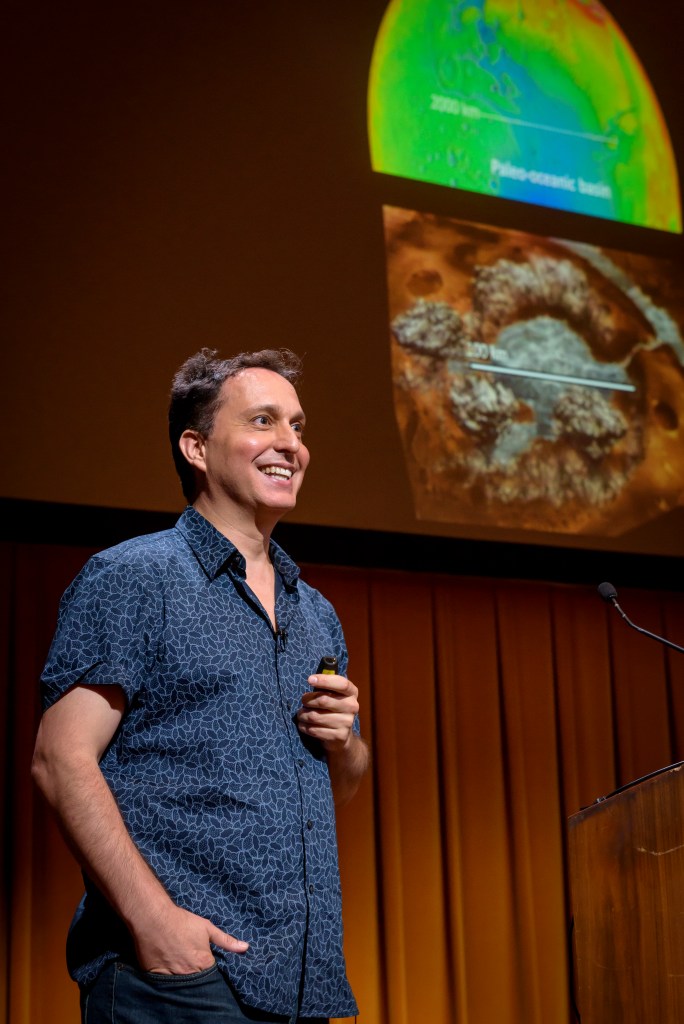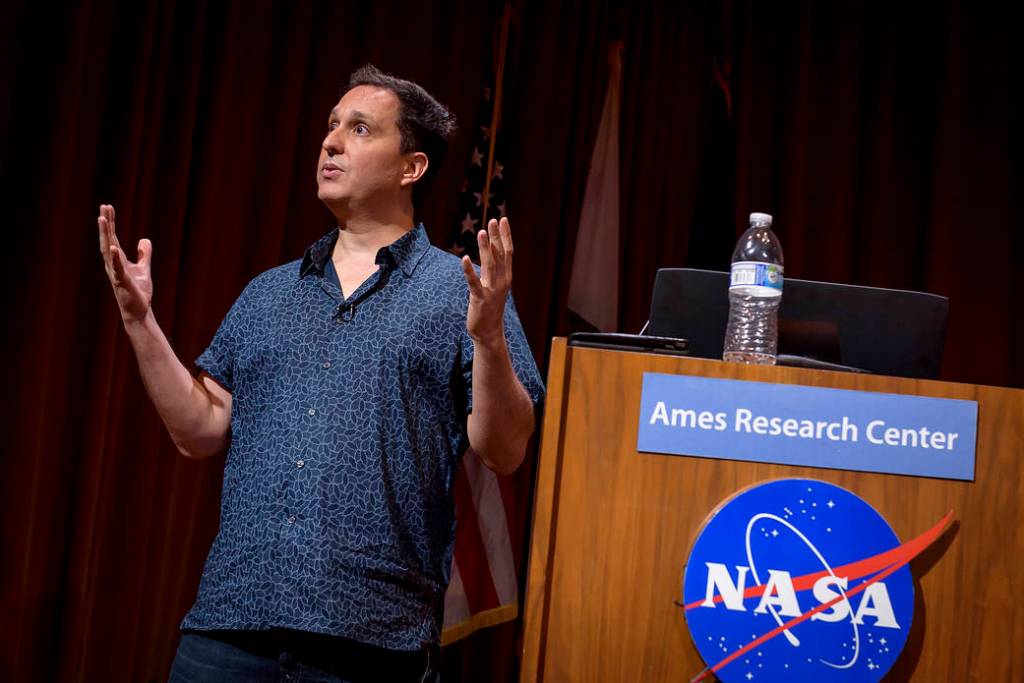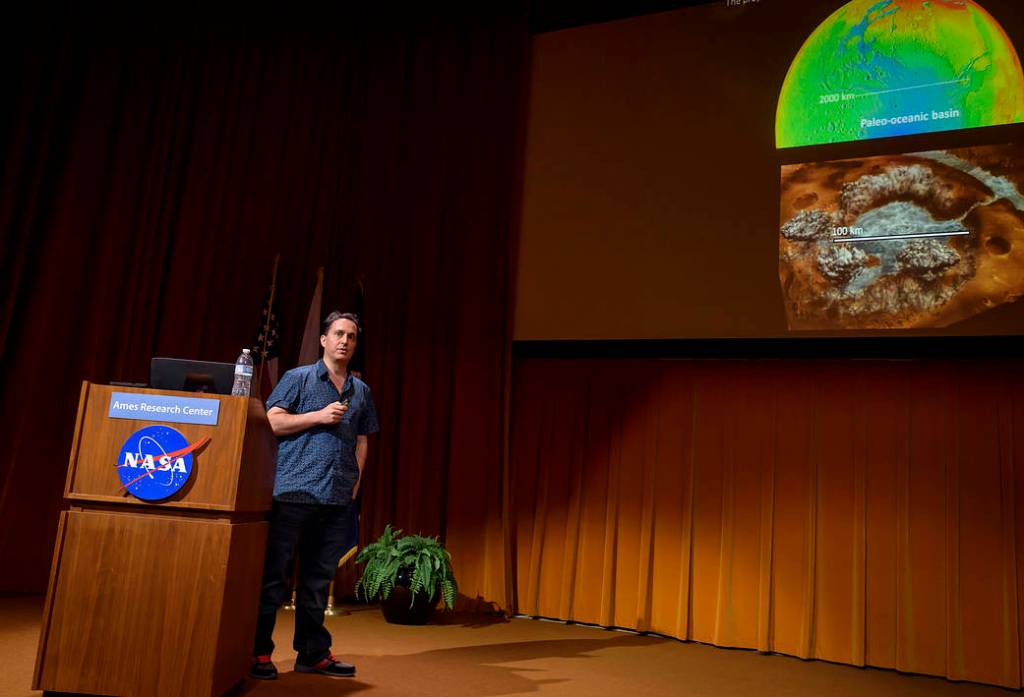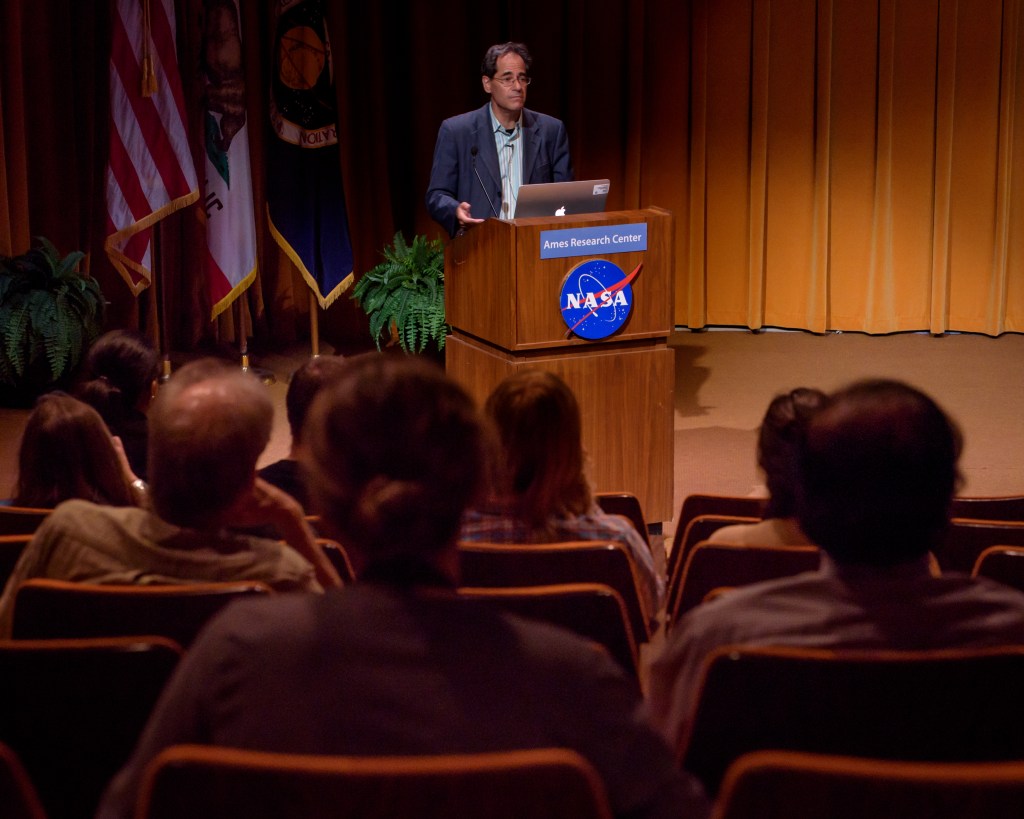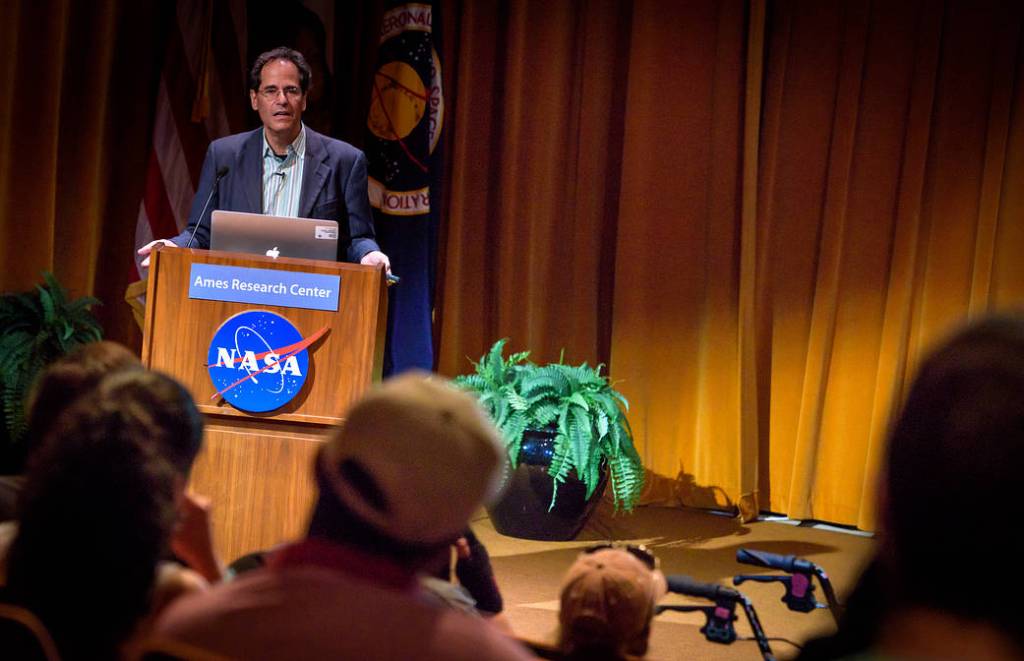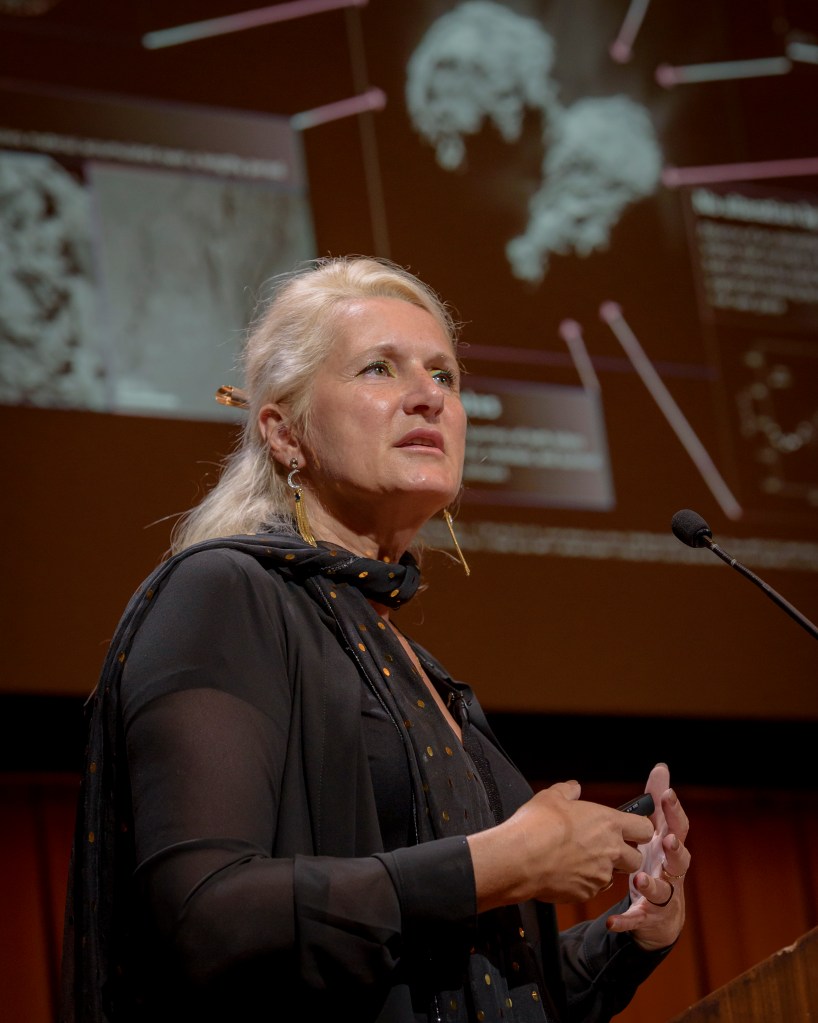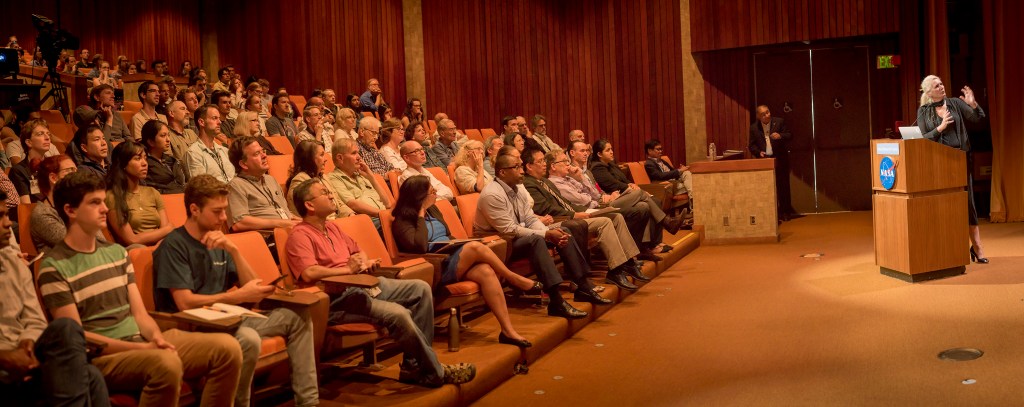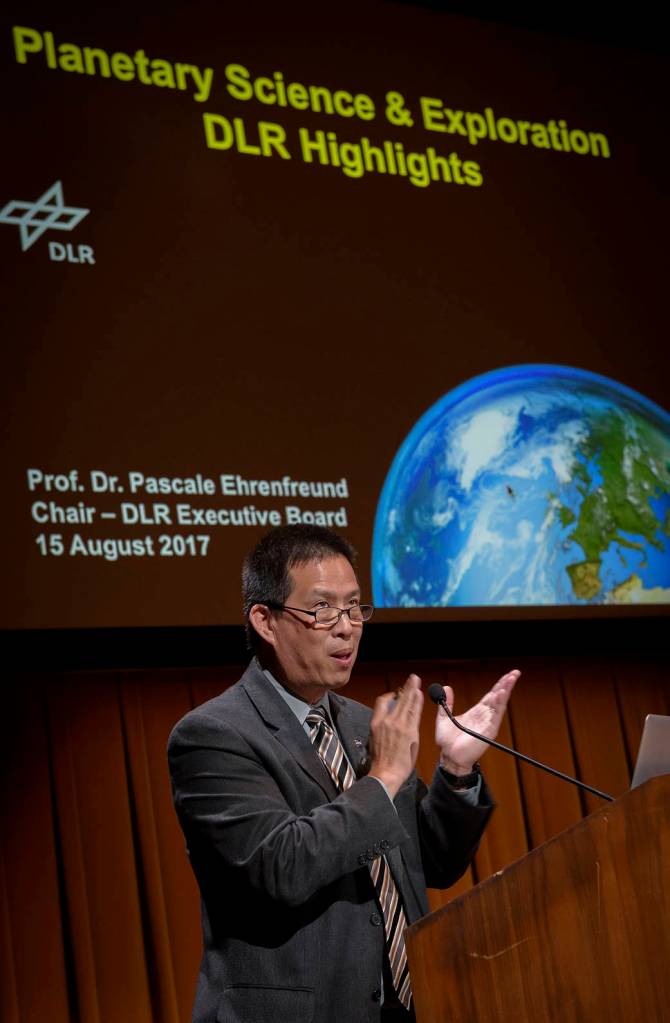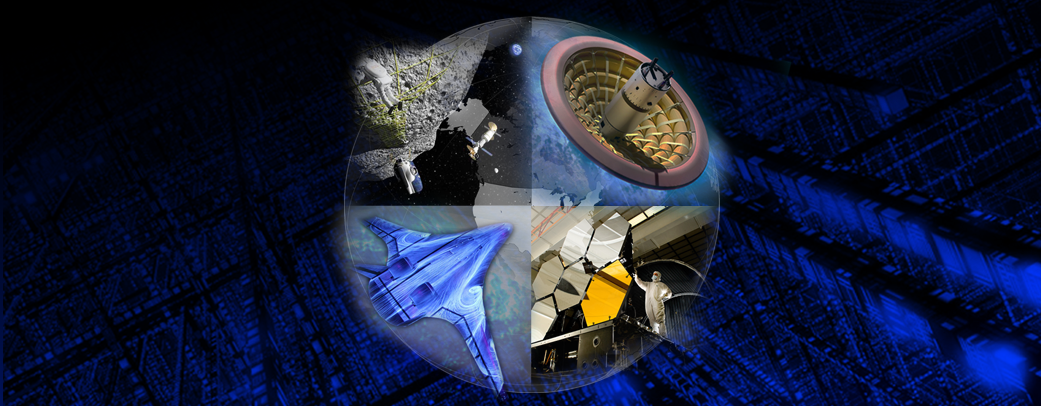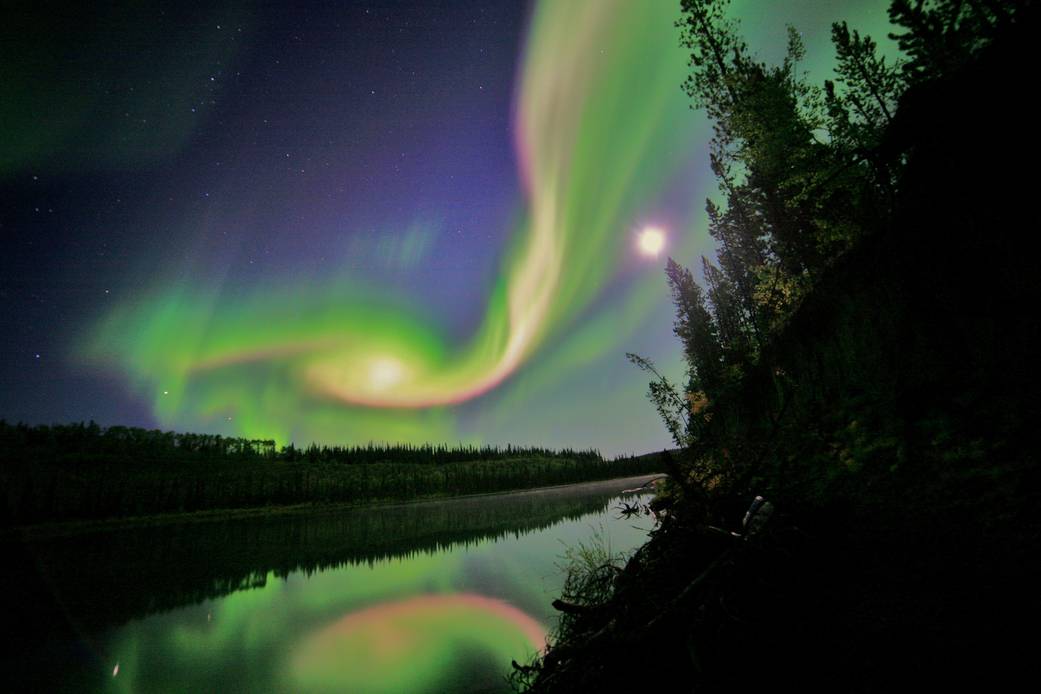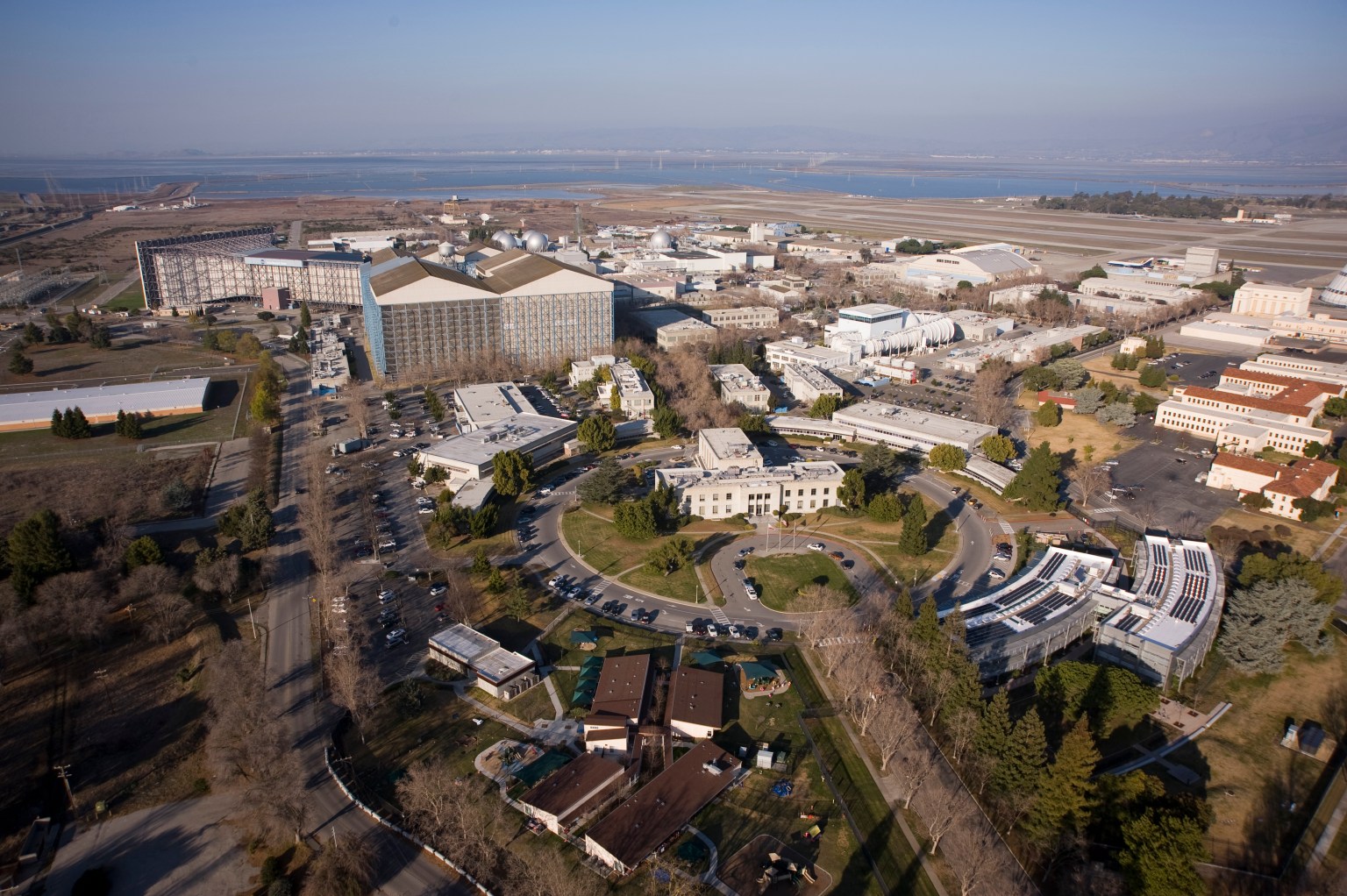2017 Summer Seminar Series
The Office of the Chief Scientist is pleased to announce the 2017 NASA Ames Summer Series. This year, the Office of the Chief Scientist has produced a platform for innovative discussion to inspire, catalyze scientific progress, share ideas, and communicate new and exciting concepts. The 2017 series consists of 16 seminars from a collection of subject leaders from and external to NASA spanning across multiple subject areas including science and technology, science fiction and exploration.
*Please note that the 2017 Summer Series was not recorded.
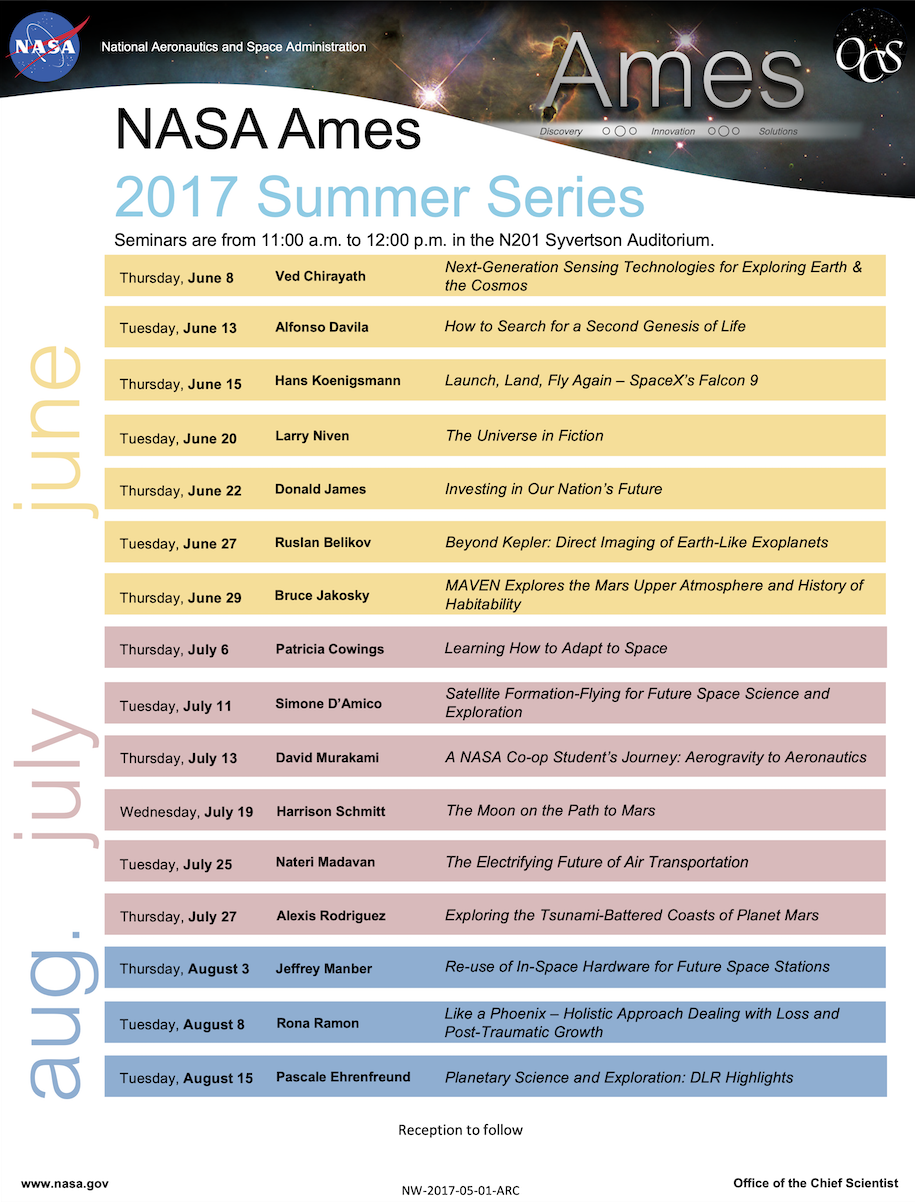 |
Ved Chirayath
Next-Generation Sensing Technology for Exploring Earth & the Cosmos
Understanding is constrained by perspective. New technology can provide a unique frame of reference that helps us gain better understanding about ourselves and the environment. NASA’s Earth Sciences research has been pivotal in developing a scientific understanding of Earth’s system and its ecosystem. Dr. Chirayath discussed novel remote sensing techniques enabling advanced scientific capabilities.
Abstract:
Dr. Ved Chirayath’s colloquium presentation will highlight two instrument technologies he invented at NASA including Fluid Lensing, the first remote sensing technology capable of imaging through ocean waves in 3D at sub-cm resolutions, and MiDAR, a next-generation active hyperspectral remote sensing and optical communications instrument. Fluid Lensing has been used to provide the first 3D multispectral imagery of shallow marine systems from unmanned aerial vehicles (UAVs, or drones), including coral reefs in American Samoa and stromatolite reefs in Hamelin Pool, Western Australia. MiDAR is being deployed on aircraft, and underwater remotely operated vehicles (ROVs) to enable a new method for remote sensing of living and nonliving structures in extreme environments. Chirayath’s talk will feature a live demonstration of the MiDAR instrument and a presentation on recent discoveries made with these instruments and their applications to understanding our home planet and sea rching for life elsewhere in the universe. More information is available online at the Laboratory for Advanced Sensing’s homepage at www.nasa.gov/ames/las
Biography:
Dr. Ved Chirayath directs the Laboratory for Advanced Sensing (LAS) in the Earth Science Division at NASA Ames. His research is directed at inventing next-generation advanced sensing technologies for NASA’s Earth Science Program to better understand the natural world around us, extending our capabilities for studying life in extreme environments on Earth, and searching for life elsewhere in the universe. He leads a multi-disciplinary team developing new instrumentation for airborne and spaceborne remote sensing, validates instrumentation through scientific field campaigns around the world, and develops machine learning algorithms to process big data on NASA’s supercomputing facility. Chirayath is the chair of NASA Ames’ Lesbian, Gay, Bisexual, and Transgender (LGBT) Advisory Group and is a Special Emphasis Program Manager for NASA HQ’s Office of Diversity and Equal Opportunity. Ved received his PhD and MSc from Stanford University’s Department of Aeronautics & Astronautics and his BSc with Honors in Physics and Astrophysics from Stanford University and Moscow State University.
Alfonso Davila
How to Search for a Second Genesis of Life
Our knowledge of life is limited. The search for life in the universe is one of the fundamental questions raised when exploring space. NASA Ames is at the forefront of understanding the effects of space on terrestrial life, determining the signatures of life, and developing the technologies needed to conduct such investigations. Dr. Davila’s seminar focused on discovery-driven methods to search for life on Mars and icy moons in our solar system.
Abstract:
There is so far only one example of life in the universe, but many habitable worlds, even in our own solar system. This motivates the search for a second genesis of life. In this talk, the concept of a second genesis of life will be discussed; past and current strategies to search for evidence of life will be critically examined; and a new approach to search for evidence of a second genesis on Mars and on icy moons will be proposed. The new strategy seeks to (1) minimize assumptions regarding the nature of a second genesis of life, (2) maximize science return even in absence of life; and (3) promote a new period of astrobiology exploration that is grounded on the scientific methods of strong inference and multiple hypotheses, a departure from more traditional, discovery-driven, efforts.
Biography:
Alfonso Davila is a research scientist in the Exobiology Branch at NASA Ames Research Center. His research focuses on the search for a second genesis of life in the solar system, using terrestrial analog environments to assess the potential habitability of other planetary bodies, and developing strategies for life detection based on first-principles in biology and biochemistry. Currently, he conducts field investigations in the most extreme deserts on Earth; provides scientific advice for the maturation of instruments for space exploration; and helps develop mission concepts to search for evidence of life on Mars, Europa and Enceladus.
Hans Koenigsmann
Launch, Land, Fly Again – SpaceX’s Falcon 9
Competition inspires novel solutions. When new commercial niches are created, companies compete and the most effective solutions thrive. NASA is supporting the era of New Space by outsourcing many Low Earth Orbit missions to the commercial sector. Dr. Koenigsmann, Vice President of Flight Reliability at SpaceX, shared SpaceX’s experience with successfully landing and re-using the first-stage of Falcon 9 rocket.
Abstract
An overview of SpaceX, with a focus on Falcon 9 will be presented. Falcon 9 has been developed with re-usability in mind, and the landing capability has been developed over the past launches without interfering with the primary mission. Both return-to-land and droneship landings will be discussed. Once recovered, the stages go through an inspection and, for the first vehicles, refurbishment. The overall goal is to reduce the turn-around time and effort between launches. So far, the Falcon 9 booster has been recovered 10 times and re-flown once, with more flight-proven missions on the manifest in the upcoming months. With the preliminary results of these missions, it can be expected that reused launch vehicles will soon be the standard.
Biography
Dr. Hans Koenigsmann leads the Build and Flight Reliability Team at SpaceX. In this role he is the executive leader of SpaceX’s quality engineering and process development teams and, oversees the launch readiness process during launch campaigns. He provides an independent assessment of launch risks, identifying and resolving anomalies during integration and launch itself. The Flight Reliability team resolves all major anomalies, evaluates and mitigates risk and performs hazard analyses and other functions on the vehicle system level.
He has more than 25 years of experience designing, developing and building complex avionics and guidance, navigation and control (GNC) systems for launch vehicles and satellites. As a member of SpaceX from the company’s inception in 2002, Hans built up the avionics, software and GNC departments and developed the launch readiness process currently in use during each launch campaign. He also designed the SpaceX risk mitigation process and initiated the risk database, establishing a similar process for system-level changes to the vehicle and ground systems. Dr. Koenigsmann was the Chief Avionics Architect of the Falcon 1 and early Falcon 9 efforts, and he is a key member of the small, core group of SpaceX engineers responsible for operating these vehicles on the launch pad and in orbit. He served as Launch Chief Engineer for the last 3 Falcon 1 missions and for most Falcon 9 flights to date.
Hans’ experience includes the development of two suborbital and two orbital launchers, as well as several satellite projects and attitude control systems. He served as head of the Space Technology Division of Germany\’s ZARM at the University of Bremen, where he was responsible for the development and operation of the satellite BREM-SAT. Following this experience, Hans worked for Microcosm as Chief Scientist and Flight Systems Manager for their suborbital vehicles.
Hans has a Ph.D. in Aerospace Engineering and Production from the University of Bremen and a Master of Science in Aerospace Engineering from the Technical University of Berlin.
Larry Niven
My Universe in Fiction
Imagination catalyzes knowledge. Science fiction often serves as an inspiration for scientific and technological advancements. Larry Niven, author of iconic works of science fiction such as Ringworld and A Mote in God’s Eye, spoke about the drivers and scientific inspirations behind his work.
Biography:
Laurence van Cott Niven was born on April 30, 1938, in Los Angeles, California. He spent most of this childhood in Beverly Hills, California. In 1956, he entered the California Institute of Technology, however he placed a hold on pursuing his degree when he discovered a bookstore jammed with used science-fiction magazines. Niven graduated with a B. A. in mathematics (and a minor in psychology) from Washburn University, Kansas, in 1962 and completed one year of graduate work in mathematics at UCLA before dropping out to write fiction for a living. He made his first sale, “The Coldest Place,” in 1964 for $25. Niven’s love of science drove him to write stories on the cutting edge of scientific discovery throughout his career. Neutron stars were a newly described phenomenon when he first wrote about them in 1966, and the modern-day theories of “dark matter” inspired him to write “The Missing Mass” in 2000. “Neutron Star” netted him his first of five Hugo awards, and “The Missing Mass” earned an award from Locus, continuing his streak into the 21st century. In between, he wrote stories about quantum black holes (following a talk with Steven Hawking), solar flares and the “real” reason Saturn’s rings appeared twisted in Voyager I’s imagery. Niven has written fiction at every length, speculative articles, speeches for high schools and colleges and conventions, television scripts, political action in support of the conquest of space, graphic novels and a couple of comic book universes. He has collaborated with a wide variety of writers including Gregory Brenford and Steven Barnes.
Donald James
Investing in Our Nation’s Future
Education fosters growth and development. Gained knowledge catalyzes innovation and results in prosperity. By engaging the public in STEM, NASA inspires the next generation of scientists, engineers and explorers. In this presentation, Donald James delved into his career trajectory, motivation and the value of education in today’s society.
Abstract:
There is something about NASA and the NASA brand that inspires people. NASA is about amazing technical and human achievement with perhaps no greater achievement in the history of humankind than the successful Apollo program. Ask just about any current and former NASA employee WHY they wanted to work with NASA and many will point to the Apollo program as their inspiration. But the most important part of the Apollo program was not the Saturn V rocket or the moon rocks returned by the Astronauts. The most important part of Apollo and ALL prior and subsequent aeronautics and space missions were the people that made it all happen. Dedicated, passionate and educated people. NASA has always recognized that it plays a special part in inspiring young people to pursue courses of study, and ultimately careers relevant to space exploration. This talk will explore how this happens and what the opportunities are for the future. Donald James also will discuss what inspired him and how his career evolved and changed and ultimately led to his dream job.
Biography:
Donald Gregory James began his NASA career as a Presidential Management Intern at Goddard in 1982. He transferred to Ames in 1984, serving in a variety of roles including Public Affairs and Government Relations and Education. James served as Ames’ Education Director from 1999 to 2006. In the Fall of 2006, he was named Project Manager for NASA’s successful bid to host the International Space University’s 2009 Summer Session Program. In August of 2014, NASA Administrator Charlie Bolden selected James to serve as the Agency’s Associate Administrator for Education. He retired after 35 years – all with NASA – on March 31, 2017. James holds a BA in International Relations from USC and a MA in International Economic Development from the American University. James also studied economics at Cambridge University and attended Harvard’s Senior Executive Fellows program. He and his wife Tanya of 28 years have two children: Brandon, a patient advocate at Stanford Children’s Hospital, and Shawna, an actor and rising senior at Boston University.
Ruslan Belikov
Beyond Kepler: Direct Imaging of Earth-Like Exoplanets
Curiosity drives exploration; exploration drives discovery. Studying the characteristics of exoplanets enables us to determine their potential habitability. The success of the Kepler Mission has placed NASA Ames at the forefront of exoplanetary research. In this presentation, Dr. Belikov introduced the opportunities and challenges in exoplanet discovery and mapping.
Abstract:
The exoplanets field has been revolutionizing astronomy over the past 20 years and shows no signs of stopping. The next big wave of exoplanet science may come from direct imaging of exoplanets. Several (non-habitable) exoplanets have already been imaged from the ground and NASA is planning an instrument for its 2020s flagship mission (WFIRST) to directly image large exoplanets. One of the key goals of the field is the detection and characterization of “Earth 2.0”, i.e. a rocky planet with an atmosphere capable of supporting life. This appears possible with several potential instruments in the late 2020s such as WFIRST with a starshade, Extremely Large Telescopes (ELTs) from the ground, or one of NASA possible flagship missions in the 2030s (HabEx or LUVOIR). Also, if an Earth-like planet exists around Alpha Centauri (A or B), it may be possible to directly image it approximately in the next 5 years with a small space mission such as the Alpha Centauri Exoplanet Satellite (ACESat). Dr. Belikov will describe the current challenges and opportunities in this exciting field, as well as the work we are doing at the Exoplanet Technologies group to enable this exciting science.
Biography:
Dr. Ruslan Belikov holds a BSE from Princeton, a Ph.D. from Stanford, and has over 10 years of experience in developing technologies and mission concepts to directly image exoplanets, especially potentially habitable ones. He is currently leading (together with Dr. Eduardo Bendek) the Exoplanet Technologies research group at NASA Ames, which has demonstrated several state-of-the-art milestones in high contrast imaging. In addition, Dr. Belikov and his team have been pioneering and advancing technologies to suppress starlight in multi-star systems such as Alpha Centauri to enable direct imaging of exoplanets there. In 2014, Dr. Belikov and Dr. Bendek led a small Explorer mission proposal to NASA called Alpha Centauri Exoplanet Satellite (ACESat) to directly image potentially habitable planets around Alpha Centauri with a very small low-cost telescope. This work has been covered or mentioned by many media outlets including the Scientific American, NYtimes, Huffington Post, and others. Dr. Belikov is also part of the coronagraph instrument team for the WFIRST mission and was a member of the Exoplanet Program Analysis Group (ExoPAG) executive committee.
Bruce Jakosky
MAVEN Explores the Mars Upper Atmosphere and History of Habitability
Studying an atmosphere leads to a greater insight of its origin. Examining a planet’s atmospheric changes enables us to better understand its environmental history. NASA Ames’ Mars Climate Modelling Center provides Mars atmospheric science and global climate modeling for NASA’s Mars Exploration Program. Dr. Bruce Jakosky discussed the results from the MAVEN mission which show that solar winds play a key role in Mars atmospheric loss.
Abstract:
The Mars Atmosphere and Volatile Evolution (MAVEN) spacecraft has been exploring the Mars upper atmosphere since fall of 2014. Its primary goal is to understand the role played by loss of atmospheric gases to space in the history of the Mars climate. It does this by examining the interactions today with the Sun and the solar wind, the response of the upper atmosphere, ionosphere, and magnetosphere to these energetic inputs, and the ways that these processes drive loss of gas to space. The evidence suggests that loss to space has been a major process (if not the major process) in changing the Mars climate from an early, warmer and wetter environment to the cold, dry environment that we see today. These results have implications for the history of the habitability of Mars by microbes, and also for the nature of habitability on planets orbiting other stars.
Biography:
Dr. Bruce Jakosky is a Professor in the Laboratory for Atmospheric and Space Physics and the Dept. of Geological Sciences at the University of Colorado in Boulder, and is Associate Director for Science at LASP. His research interests are in the geology of planetary surfaces, the evolution of the Martian atmosphere and climate, the potential for life on Mars and elsewhere, and the philosophical and societal issues in astrobiology. He headed the University of Colorado’s team in the NASA Astrobiology Institute for more than ten years, and is the Principal Investigator of the Mars Atmosphere and Volatile Evolution (MAVEN) mission to Mars. He has published about 200 papers in the refereed scientific literature, and has authored or co-authored a number of books, including “The Search for Life on Other Planets” and “Science, Society, and the Search for Life in the Universe.”
Patricia Cowings
Learning How to Adapt to Space
Foresight increases the probability of survival. Given prior insight, the Human body may be able to modify its physiological conditions to mitigate or reduce environmental effects. The Human System Integration Division at NASA Ames conducts research into the development of countermeasures for aerospace operation hazards. Dr. Patricia Cowings presented the concepts of Autogenic-Feedback Training Exercise and discussed the benefits of using this procedure for mitigating the effects of Human spaceflight.
Abstract:
NASA has identified a potential risk of spatial disorientation to future astronauts during re-entry of the proposed Orion spacecraft. The purpose of this study was to determine if a 6-hour physiological training procedure, Autogenic-Feedback Training Exercise (AFTE), can mitigate these effects. Twenty subjects were assigned to two groups (AFTE and Control) matched for motion sickness susceptibility and gender. All subjects received a standard rotating chair test to determine motion sickness susceptibility; three training sessions on a manual performance task; and four exposures to a simulated Orion re-entry test in the rotating chair. Treatment subjects were given two hours of AFTE training before each Orion test. A diagnostic scale was used to evaluate motion sickness symptom severity. Results showed that 2 hours of AFTE significantly reduced motion sickness symptoms during the second Orion test. AFTE subjects were able to maintain lower heart rates and skin conductance levels and other responses than the control group subjects during subsequent tests. Trends show that performance was less degraded for AFTE subjects. The results of this study indicate that astronauts could benefit from receiving at least 2 hours of preflight AFTE. In addition, flight crews could benefit further by practicing physiologic self-regulation using mobile devices.
Biography:
Dr. Patricia Cowings is a research scientist at NASA Ames Research Center in the Human Systems Integration Division. She is the Principal Investigator of the Psychophysiological Research Laboratory and in 1978 became the first American Woman to receive scientist astronaut training. She is the inventor of Autogenic-Feedback Training (AFTE): systems and methods, which was patented by NASA in 1997. AFTE can be used to train people to voluntarily control 24 of their bodily responses (breathing, heart rate, sweating, etc.). Her current work is in support of the Human Research Program, Human Health Countermeasures Element which involves evaluating this physiological training method as a countermeasure for spatial disorientation and motion sickness impacting crew during spacecraft re-entry and vehicle egress. Her past work included supporting the Advanced Exploration Systems, Deep Space Habitat project by providing expertise and hardware tests of ambulatory physiological monitoring equipment worn by crew during four 30-day simulations at JSC. This work supports the NASA’s goal of maintaining optimal behavioral health and performance in autonomous crews through self-monitoring. In earlier work, she served as a principal investigator on three Space Shuttle Flight experiments and as primary American collaborator in an experiment flown aboard the Russian Mir Space Station. The latter study evaluated AFTE as a countermeasure for post-flight orthostatic intolerance and maintenance of behavioral health during long duration spaceflight. All flight experiments involved monitoring and correcting human autonomic responses to spaceflight. Her project team developed a crew worn physiological monitoring system that was successfully flown during these missions, and has been used in ground-based studies with the military to evaluate and correct responses to extreme environments. She received her PhD from the University of California at Davis and her thesis work, development of AFTE, was conducted at the Rockefeller University in New York. She has three brothers, (an army major general, a jazz musician and a free-lance journalist), and grew up in the Bronx. Her dad had a grocery store and her mom taught pre-school.
Simone D’Amico
Satellite Formation-Flying for Future Space Science and Exploration
Collaboration enhances success and increases efficiency. Distributed systems utilize the collaborative capabilities of its components, making them more effective than the monolithic system. NASA Ames’ Intelligent Systems Division has led the Agency in developing distributed robotics systems through their next-generation control architectures and advanced autonomous systems. Dr. D’Amico discussed the advancements made in the field of Astrodynamics and Guidance, Navigation, and Control algorithms.
Abstract:
Distributed space systems (DSS) are space architectures composed of multiple interacting satellites, typically small, that are intended to accomplish scientific or commercial objectives otherwise impossible or very difficult to achieve through a single monolithic spacecraft. DSS represent a change of paradigm in the way humans do spaceflight and, in the next few decades, are expected to provide breakthroughs in earth/planetary science, in astronomy/astrophysics, as well as space exploration and on-orbit-servicing. This research arises from the awareness that the science and practice of navigating DSS requires tremendous progress before the aforementioned applications and new opportunities become a reality, especially when employing miniaturized platforms with limited on-board resources. This presentation addresses the new astrodynamics and Guidance, Navigation and Control (GN&C) algorithms under development to meet the tight requirements of future DSS. A novel low-cost mission concept is introduced, the so-called miniaturized Distributed Occulter/Telescope (mDOT). mDOT consists of two small formation-flying satellites precisely positioned in high-elliptical-orbit to directly image exozodiacal dust and exoplanets. Finally, the Stanford’s high-fidelity robotic testbed for the evaluation of the proposed sensors and navigation algorithms is described.
Biography:
Simone D’Amico is an Assistant Professor of Aeronautics and Astronautics at Stanford. He is founder and director of the Space Rendezvous Laboratory. He is a Terman Faculty Fellow and Satellite Advisor of the Stanford’s Student Space Initiative. He holds a Ph.D. in aerospace engineering from the Technical University of Delft and received his B.S. and M.S. degrees from Politecnico di Milano. Prior to Stanford, Dr. D’Amico was at the German Space Operations Center for 11 years where he gave key contributions to the design, development, and operations of spacecraft formation-flying and rendezvous missions such as GRACE, TanDEM-X, and PRISMA. Dr. D’Amico has over 100 scientific publications including conference proceedings and peer-reviewed journal articles. He is Program Committee Member of the International Workshop on Satellite Constellations and Formation Flying and of the Stanford’s Position, Navigation, and Time Symposium. He is Associate Editor of the AIAA Journal of Guidance, Control, and Dynamics. Dr. D’Amico received a number of awards for his scientific achievements such as the DLR’s Sabbatical/Forschungssemester (2012), the DLR’s Wissenschaft Preis (2006), and the NASA’s GRACE Group Achievement Award (2004).
David Murakami
A NASA Co-op Student’s Journey: Aerogravity to Aeronautics
Optimized complex testing methods revolutionize aeronautics. The National Advisory Committee for Aeronautics’ (NACA) Ames Aeronautical Laboratory is the predecessor for NASA Ames Research Center. Today, it continues to provide technologies and expertise that enable Agency aeronautic missions. Ames houses the largest wind tunnel in the world, National Full-Scale Aerodynamics Complex, which has supported testing for various missions including Mercury, Apollo, Space Shuttle program, Mars Science Laboratory, etc. In this presentation, Dr. Murakami discussed the significance and technological capabilities of the wind tunnels at NASA Ames.
Abstract:
NASA Ames Research Center has a long history of advancing the state of the art in aeronautics. Its distinguished wind tunnel facilities, some constructed under NASA’s predecessor (NACA), continue to play a vital role in accomplishing NASA’s missions. This presentation will introduce these wind tunnels and the significant impact they make, with a particular focus on the advanced measurement techniques employed by the Fluid Mechanics Laboratory. Techniques such as pressure sensitive paint, background-oriented schlieren, particle image velocimetry, and photogrammetry will be discussed, as well as their application in aircraft, planetary probe, launch vehicle, and even tractor-trailer testing. In addition, Dr. Murakami is a recent PhD graduate and alumnus of the NASA Pathways co-op program, and provides a perspective that may be particularly relevant to our summer interns. The talk will also cover his experiences through an early career deeply shaped by NASA, and the path of his research from microwave powered rockets, to a dissertation on aerogravity assist maneuvers for spacecraft, to his current work in the Fluid Mechanics Laboratory.
Biography:
David Murakami is an aerospace engineer in the Fluid Mechanics Laboratory at Ames, where he is currently involved in development of an unsteady pressure sensitive paint system for use in the wind tunnels. He is also a recent doctoral graduate from the Department of Aeronautics and Astronautics at Stanford University. As part of the NASA Pathways co-op program, he has worked at Ames while pursuing his MS and PhD at Stanford. He received his BS with a double major in Aerospace Engineering and Physics from California State University, Long Beach. His long involvement with NASA began with an undergraduate internship at NASA Armstrong, which was followed by a summer in the NASA Academy program at Ames, then the graduate NASA Pathways co-op program. He has benefited from a rich experience in the program, where his work as a test engineer provided opportunities to develop a wide variety of skills, and took him not only to the many wind tunnels on the center but also to remote Department of Defense test ranges and the DIII-D fusion research tokamak reactor.
Senator Harrison Schmitt
The Moon on the Path to Mars
“It’s like trying to describe what you feel when you’re standing on the rim of the Grand Canyon or remembering your first love or the birth of your child. You have to be there to really know what it’s like.” – Harrison Schmitt, Apollo 17, 1972, Moon.
Humans landing on the Moon still resonates as an inspiration and hope for future exploration. 44 years after the last Apollo mission, the Moon is now seen as a frontier for resource utilization and international collaboration by the emerging commercial industry and space agencies around the globe. In this presentation, Senator Schmitt discussed the significance of the scientific data and lunar sample collected during the Apollo era.
Abstract:
Apollo 17 landed in the valley of Taurus-Littrow on December 11, 1972, after a spectacular night launch of the last Saturn V to propel a spaceflight beyond near Earth orbit. The narrow, 7 km wide valley is surrounded by mountains 1600-2100 m high and is partially filled by mare basalt flows. After 3 EVAs totaling 22 hours, the crew conducted geological exploration and experiment deployments across about 250 km2 of the valley and returned 110 kg of lunar samples to Earth. These samples, the crew’s observations and photographs, and data from geophysical experiments, continue to provide insights into the origin and evolution of the Moon and terrestrial planets, including information about the lunar mantle, formation of large impact basins, pyroclastic volcanism, and processes still active in modifying the lunar surface. Most importantly, the data from Apollo 17, in conjunction with that of other Apollo missions and later orbital remote sensing, has provided increased constraints on the early history of the Earth during an ~800 million period of large-scale impact. It was during this time that replicating life forms came into being on our planet and possibly temporarily on Mars. The Apollo 17 mission spent 301 hours in space, splashing down in the South Pacific on its return to Earth.
Biography:
Senator Harrison Hagan Schmitt was born in New Mexico and grew up in the American West. He received a Bachelor’s of Science degree from Caltech and a PhD in geology from Harvard based on field work in Norway as a Fulbright Scholar and National Science Foundation Post-Doctorate Fellow. Selected by NASA as a Scientist-Astronaut in 1965, he earned Air Force T-38 jet pilot wings in 1966 and Navy H-13 helicopter wings in 1967. Schmitt flew in space as Apollo 17’s Lunar Module Pilot, landing in the Moon’s Valley of Taurus-Littrow, December 11, 1972. He is the only scientist and last of 12 men to step on the Moon. Schmitt was elected to the United States Senate from New Mexico in 1976. As part of his consulting business in aerospace and earth science, he chaired the NASA Advisory Council from 2005 to 2008. Schmitt has received numerous honorary degrees from United States and Canadian universities. From 1996 to 2004, he taught “Resources from Space” at the University of Wisconsin-Madison and is an Associate Fellow in the University’s Department of Engineering. Schmitt authored “Return to the Moon; Exploration, Enterprise and Energy in the Human Exploration of Space” and, since 1964, he has published numerous scientific papers related to lunar and planetary geology. He travels extensively internationally as well as domestically. Schmitt lives with his family in the American intermountain West.
Rona Ramon
Like a Phoenix – Holistic Approach to Dealing with Loss and Post-Traumatic Growth
Role-models are created by overcoming hardships and failures. Adversity provides different perspectives that inspire change, new opportunities and accomplishments. Rona Ramon, one of Israel’s respected education leaders, shared her journey of coping with personal tragedy and how that lead her to encourage Israel’s young generation to achieve their dreams and aspirations.
Abstract:
Rona’s fascinating lecture includes insights from her research on growth and transformation after grief. As the spouse of Israel’s first astronaut, she recounts her unique story by sharing the changes she had to make throughout her life and her process of coping with loss in the public eye. Rona depicts the journey through identity and meaning, drawing lessons of faith and a message for a rich, fulfilled life from a storm of chaos.
Biography:
Rona has been practicing holistic medicine for over twenty years. She holds a Bachelor’s Degree in Physical Education from the Wingate Institute and a Master’s Degree in Holistic Health from Lesley University. Her thesis on “The process of growth and transformation following loss” serves Rona as a foundation for treating her patients and giving them the tools to cope with grief. Rona serves as Acting President of the Ramon Foundation, established in 2010. In the spirit of Ilan Ramon and the values he exemplified, the Foundation aims to encourage Israel’s young generation towards academic excellence, social leadership, and daring innovation. Born in Kiryat Ono in 1964, Rona served as a paramedic in the IDF’s Paratroopers Brigade. Aged twenty-two, she married Ilan and together they raised four children. In 1998, they moved to Houston as part of the preparations for flight STS 107. In 2003, Ilan, the first Israeli astronaut, perished as the Columbia Space Shuttle disintegrated while reentering the atmosphere. In 2009, Rona’s son Asaf was killed when his F-16 crashed during a training flight.
“Drawing on my life experience and academic research, I have found that my purpose as a lecturer and a therapist is to emphasize and instill the contribution of the holistic approach to our process of growth and to our quality of life.”
Nateri Madavan
The Electrifying Future of Air Transportation
Innovation generates novel niches. The change from mechanical to electrical dependency was disruptive. The Advanced Air Transport Technology (AATT) project at Ames is designing electrical aircraft that enable higher reliability, energy efficiency and environmental compatibility. Dr. Madavan provided an overview of the electrification of air transportation and its effects on the future.
Abstract:
Air transportation is poised on the brink of a revolution that is being primarily driven by electrification. The world has already witnessed the impact of electrification on other modes of transportation – rail, marine, and road – and it is now aviation’s turn. NASA Aeronautics is working with its partners to develop a new class of power, propulsion, airframe, and thermal technologies that will enable quieter, cleaner, and more efficient aircraft. Together with new aircraft configurations and concepts of operations, these technologies will support new flight applications such as intra-urban on-demand air mobility and regional airport utilization, and will also lead to radically new large transport aircraft. These technologies are part of NASA Aeronautics’ overall research portfolio that address its strategic thrusts of developing ultra-efficient commercial aircraft and alternative low-carbon propulsion and energy systems to enable safe and sustainable future growth in global aviation. This presentation will provide an overview of how electrification will affect the future of air transportation and the opportunities and challenges that it presents, and describes some of the related concepts and enabling technologies that are currently being developed.
Biography:
Nateri Madavan currently serves as the Associate Project Manager for Technology for the Advanced Air Transport Technology Project in NASA’s Advanced Air Vehicles Program and helps manage the Project’s research portfolio to enable revolutionary improvements in the energy efficiency and environmental compatibility of future generations of aircraft. He is based at NASA Ames Research Center where he is a member of the Computational Aerosciences Branch in the NASA Advanced Supercomputing Division. Before moving to project management, Dr. Madavan pursued research in the areas of computational fluid dynamics (CFD) software development and application, and high performance scientific computing. He has been recognized through various NASA honor, space act, group achievement, and tech transfer awards over the years, and he is also a two-time recipient of the NASA Outstanding Leadership Medal, most recently in 2017. Dr. Madavan obtained his BS degree from the Indian Institute of Technology at Kharagpur, MS from Iowa State, and PhD from Penn State, all in Mechanical Engineering, and is an Associate Fellow of the AIAA.
Alexis Rodriguez
Exploring the Tsunami-Battered Coasts of Planet Mars
New evidence reawakens old hypotheses. The question of whether the red planet may have once been blue surfaces again with the discovery of evidence supporting ancient tsunamis on Mars. This is of particular interest to NASA Ames as it is invested in uncovering evidence of water on Mars an essential step along the way to supporting extraterrestrial life. Dr. Alexis Rodriguez, a research scientist at the Planetary Science Institute, elaborated on a specific region of Mars containing tsunami deposits that could serve as a leading candidate for a landing site to search for evidence of Martian life.
Abstract:
Dramatic landscapes generated by mega-tsunamis appear to have characterized the coastal terrains of early Mars. Potential tsunami-related features include enormous sedimentary lobes, interpreted to have been emplaced by waves with heights reaching ~100 m at shoreline levels. While the lobes likely include displaced submarine floor materials, they generally do not constitute suitable targets for the in-situ exploration of the planet’s ancient submarine environments. This is because, as Earth studies show, these deposits also typically include significant amounts of debris ingested during overland flow. In my talk, I will document a unique Martian coastal area, which includes potential tsunami deposits free of this type of “contamination”; and which thus, comprises a top landing site candidate.
Biography:
Dr. Alexis Rodriguez was raised in the Canary Islands; a subtropical archipelago located in northwestern Africa. He has traveled extensively around the world and resided long-term in Spain, the U.K., Japan, and in the United States. He obtained his PhD in planetary science at the University of Tokyo in 2004 under the supervision of Professor Sho Sasaki. Since 2008 he has been working as a Research Scientist at the Planetary Science Institute in Tucson, Arizona. However, in 2013 he moved to Ames under a NPP fellowship, where he spent 2 years at Ginny Gulick’s laboratory. His primary research interests are investigations of Martian landscapes produced by catastrophic processes and of their terrestrial analogues. Some key discoveries include evidence of potential Martian tsunami deposits as well as of possible structured left behind by subterranean rivers that fed into the planet’s largest channels. In his free time, he enjoys hiking and traveling throughout Asia and South America.
Jeffrey Manber
Re-use of In-Space Hardware for Future Space Stations
Abstract:
We are fast approaching an era of commercially provided factories, warehouses, fuel depots and, what is somewhat nostalgically referred to as, space stations throughout the space frontier. Markets for in-space platforms include everything from manufacturing of satellites and high value products, such as thin-film wafer and fiber optics, to storage of resources from Earth and asteroids. In-space platforms are the stepping-stones to deep space exploration and hotels. In short, we are fast approaching a construction boom, but only if the costs are low enough to compliment and leverage the market activity. NanoRacks is looking at re-using in-space hardware, including the second stages of certain launch vehicles to keep the costs low and yet have a supply chain to meet the need of entrepreneurs; whether Jeff Bezos and his millions of workers and thousands of envisioned factories, of the Asteroid Mining companies and to support Lunar Villages and Elon Musk’s settlers to Mars. We are conducting studies and developing the foundation needed to best meet this extraordinary infrastructure boom, which will revolutionize our exploration, utilization and self-understanding of who we are as humans on this planet. Jeff Manber will discuss the details of potential first steps and how NASA and others are supporting this effort.
Biography:
For over two decades now, Jeff Manber has worked to open space exploration to commercial interests, in order to make space another place to do business. Today, he is regarded by many as a pioneer in helping bring about this new chapter in our exploration of outer space. Currently, as CEO of NanoRacks from 2009 onwards, Jeff has steered the growth of the first company to own and market its own services as part of the U.S. National Lab on ISS. In just seven years, NanoRacks has flown over 500 commercial payloads, from biopharma research to education and has deployed over 180 satellites for customers from more than 30 nations, including, most recently, the first commercial Chinese research project, from Beijing Institute of Technology NanoRacks is today starting a new phase, focusing more on its own commercial habitats and stations. Previous to NanoRacks, Jeff helped open the door between the Russians and Americans, first as head of the Energia USA and later as CEO of the Dutch company MirCorp. MirCorp leased the Russian space station Mir and had a multi-million backlog when the station was forced to deorbit. The author of numerous articles and several books, including “Selling Peace,” which chronicles Jeff’s time working with the Russian space program.
Pascale Ehrenfreund
Planetary Science and Exploration: DLR Highlights
Abstract:
The German Aerospace Center (DLR) carries out and supports research programs on the internal structure, formation and evolution of planets, their moons, asteroids and comets. DLR has conducted/operated and participated in numerous space missions that have achieved excellent scientific results and created new knowledge about our solar system and the universe. Outstanding examples of DLR leadership include the Philae lander of ESA’s Rosetta mission, as well as key instruments on Mars Express. The MASCOT lander on the Japanese Hayabusa-2 mission and the Framing Cameras on NASA´s DAWN mission to Ceres and Vesta demonstrate the successful development of DLR instruments and technologies for international missions. DLR is contributing to exciting future planetary missions such as NASA’s InSight, the European/Russian ExoMars2020 rover, as well as ESA´s JUICE mission to Jupiter. Additionally, DLR is engaging in the search for exoplanets, participating in the ESA missions PLATO and CHEOPS. DLR also conducts a large research program on the International Space Station. This presentation will provide an overview of DLR highlights of ongoing and future missions in planetary science and exploration.
Biography:
Dr. Pascale Ehrenfreund is currently the Chair of the Executive Board of the German Aerospace Center (DLR). She is also a Research Professor of Space Policy and International Affairs at the Space Policy Institute in Washington DC and Professor at Leiden Observatory, the Netherlands. Her research experience and interest range from biology to astrophysics with special emphasis on astrochemistry and the search for life on Mars. Since two decades she contributed as Project Scientist, Principal Investigator, Co-Investigator and Teamleader to ESA and NASA astronomy and planetary missions as well as experiments in low Earth orbit and on the International Space Station. Pascale Ehrenfreund authored and co-authored more than 300 publications (Citation Index: h=63) and edited 12 books. From 2013-2015 she was the first female President of the Austrian Science Fund (FWF). Pascale Ehrenfreund holds a Master degree in Molecular Biology from the University of Vienna, a PhD in Astrophysics from the University Vienna/Univ. Paris VII, and a Master degree in Management & Leadership from Webster University. She has also been present in outer space since 1999, as the asteroid “9826 Ehrenfreund 2114 T-3” bears her name.















